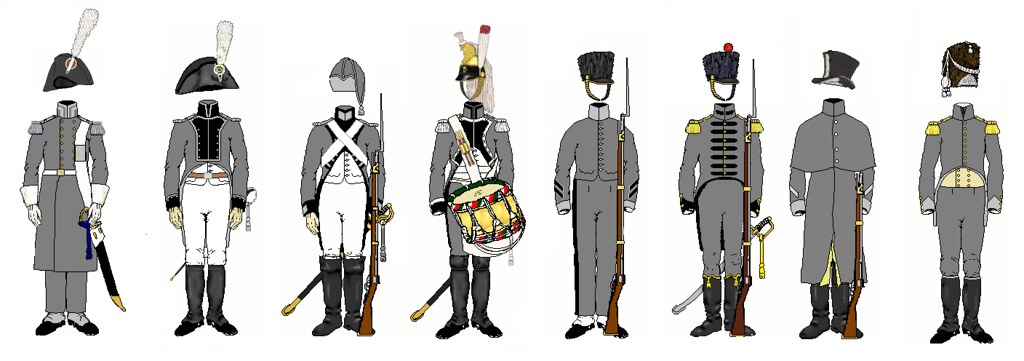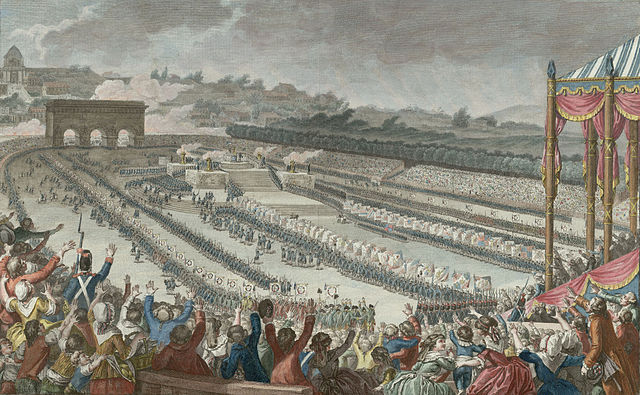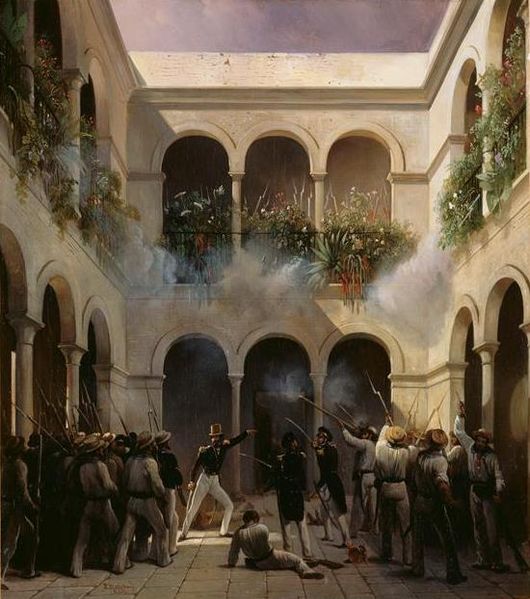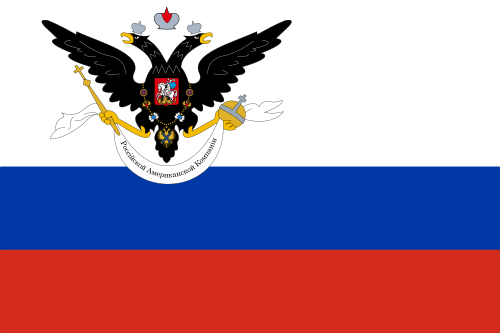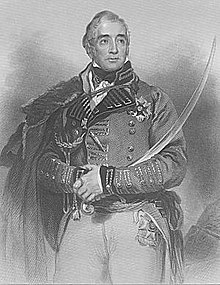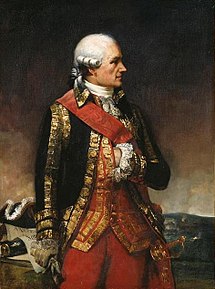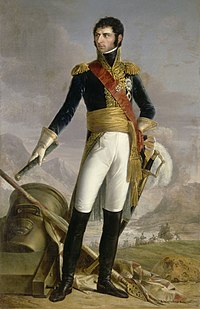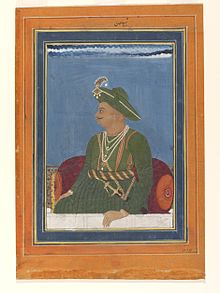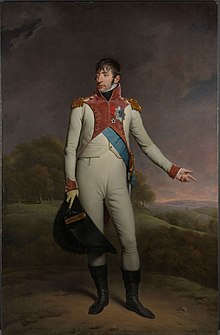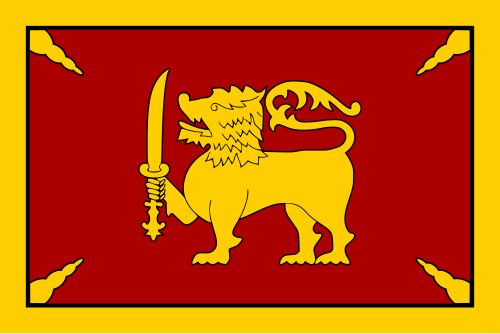This thread is for the American King story only. I would post it in the Finished Timelines and Scenarios section, but this isn't even near finished in any sense of the word. Comments, which are much appreciated (  ), should go here: https://www.alternatehistory.com/discussion/showthread.php?t=231767
), should go here: https://www.alternatehistory.com/discussion/showthread.php?t=231767
American King: Take Two
“Surely oppression maketh a wise man mad”
-Ecclesiastes 7:7
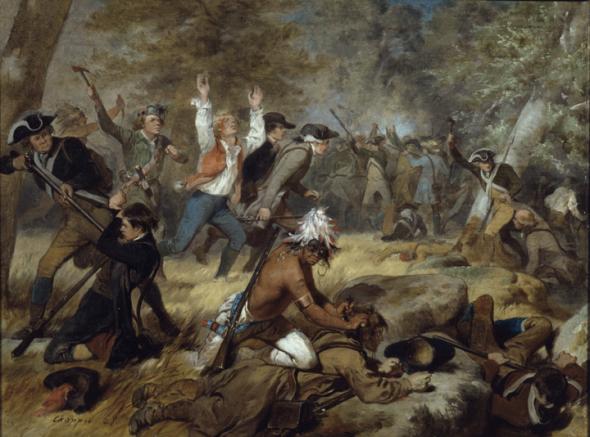
Massacre of the Tories by the Sons of Liberty by Alonzo Chappel
To fully understand the events of the Great Revolution, we must go back to earlier decades of the Glorious Century, the 1700's. Following France's defeat in the Seven Years' War (1756-63), and the rise of Britain as the supreme world power, Louis XV, great-grandson of the Sun King himself, was forced to sign away most of France's New World colonies. This left Britain extremely wealthy. But still, it had war debts, as it also fought alongside Frederick II, the Great, against the Austrians and French in mainland Europe. King George III (who succeeded his grandfather George II in 1760) was the latest British sovereign of the House of Hanover, and he needed tax money, and the American colonies were a great source of income. After all, the colonists had had the protection of the mighty British army and navy during the Seven Years' War, so why should they not pay for it? The King could not run the government for free, after all. Even after the Seven Years', as late as 1766, the Redcoats were fighting Pontiac's Rebellion against those Indian tribes formerly allied to the French. On October 7th, 1763, George set up the Proclamation Line to protect those "infernal colonists," and they were not even grateful! Taxes, taxes, and, above all, more taxes, were required to pay for the New World shenanigans and the expanding empire. The Parliament soon issued the Sugar and Currency Acts (1764), taking away the colonies' rights to print money, and claiming, "It is expedient that new provisions and regulations should be established for improving the revenue of this Kingdom ... and ... it is just and necessary that a revenue should be raised ... for defraying the expenses of defending, protecting, and securing the same." Shockingly, these acts proved wildly unpopular and the colonists rioted in the streets. Late to the party was the Stamp Act (1765), which infuriated most Americans. Riots and violence broke out, which the British mercilessly crushed. Virginia's Burgesses claimed the motherland could not tax Virginians under British law; "only Virginians can tax Virginians." The final kick in the crotch came with the enactment of the Quartering Act, allowing roving mobs of British soldiers and sailors to "loot, pillage, and make themselves at home on private property."
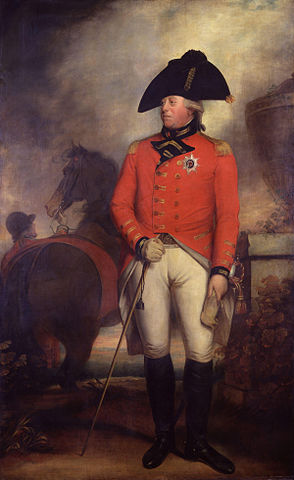
George III, By the Grace of God, of Great Britain, France and Ireland, King, Defender of the Faith, Prince-Elector of Hanover, Duke of Brunswick
The Parliament's refusal to repeal the Stamp and Quartering Acts resulted in the New York Rebellion of 1766, when New Yorkers took up arms against the British garrisons. After the quickly-but-bloodily-won victory by the British government, New York's government was suspended and numerous arrests ensued, including that of revolutionary Seven Years' War veteran Captain James DeLancey, a member of the radical Sons of Liberty movement.
After squashing the New York Independence movement, the King and Parliament flaunted their victory with the Declaratory Act, essentially rubbing in the colonists' faces that, "We can do what we want, when we want, for whatever reason we want, and you cannot do anything about it," along with the Townshend Act, yet another tax.
Burgeoning under all these unwanted tyrannies, many colonists became open opponents of Britain. King George watched with shock and anger, in March 5th, 1770, shortly after the election of Lord North as Prime Minister, as Americans, upon reading To the Betrayed Inhabitants of the City of Boston (a Sons of Liberty broadside), seized fifty sleeping British troops garrisoned in Boston, dragged them out of their barracks, impaled them "like flags" upon pikes, and hoisted the corpses at Boston Harbour for all to see. It was known as "The Bostonian Massacre," and it made the English cry out for revenge. It was not long before they would have it.
The so-called "War of the Regulation" (1765-1770), in western North Carolina, was a rebellion of the citizens against the colonial government in protest to the "Intolerable Acts" passed by Parliament. The British knew it could incite unrest in the other areas, especially after The Bostonian Massacre, and immediately brought in professional soldiers to assist Governor William Tyron in crushing the insurgency. At the Battle of Alamance, over three hundred rebels were captured by Redcoats and executed. In retaliation, a mob in New York City, a location under martial law since the Rebellion of '66, stormed a compound, freeing numerous prisoners and taking hostage five hundred British troops. They then declared that they would execute ten soldiers every day until the Intolerable Acts were repealed. They practiced what they preached: the next day, ten bodies were hoisted on pikes at Wall Street. After ten days, and one hundred executions, a British counter-attack liberated the prisoners and forced the rebels to flee for their lives. The Wall Street Hostage Crisis was over.
From this time forth, North America plummeted into violence and riots. Following the Hostage Crisis, Sam Adams, a leader of the Sons of Liberty, formed the Committee of Correspondence. This heavily-Masonic organization pulled the strings of power in America, much to the disgruntlement of King George. A further black eye for the crown was the newly-formed (1772) Watauga Republic, along the Louisiana border, which was formed by settlers pushing the limits of the Proclamation Line.
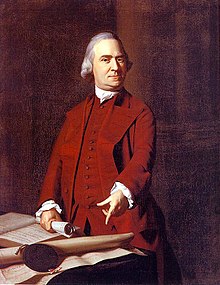
Samuel Adams
Britain responded with the Tea Act. This new act was designed by the East India Company to sell its hugely overpriced tea to the colonists, who would have to pay Townshend Duties, making it even more expensive. The Sons of Liberty, now on the ascension to supreme power over all independence/anti-Britain movements, retaliated with the Boston Tea Party. The Sons of Liberty chapter in Boston, Massachusetts Bay, disguised themselves as Indians, complete with tea-stained skin, turbans, scimitars, and explosives, and attacked the ships tied to the docks, massacring the sailors, throwing the tea overboard, and burning the boats. Numerous ships, however, were privateered and taken to an undisclosed location, crewed, repainted, and sent out to sea. That marked the start of the Pirate War (1773-75). British civilian ships were seized, hostages taken, property destroyed, and sunk-- if they could not be used as yet more pirate vessels. The Royal Navy was then stretched to its full capacity as piracy broke out all over the empire, inspired by the Tea Party.
Parliament had had enough. They quickly passed the Massachusetts Bay and New York Governing Act, which removed all colonial authorities, installed new ones, raised taxes, beefed up occupational troops, and made support of revolt punishable by death. It was followed quickly by the Proclamation Line of 1774, which pushed the Line of 1763 back east even further, and sent in troops to order and monitor settler relocation. While this helped the all-seeing eye of George watch and control more easily for a while, it made the western rural families and towns hate his guts. The Watauga Republic prepared violent resistance against the Line of 1774. Making the matters worse was the Second Quartering Act and the Administration of Justice Act of 1774, which essentially allowed local officials to persecute, execute, or exile anyone they wanted and crush uprisings and protests by whatever means necessary.
Violence was to reign supreme during the Powder Confiscation of September 1st, 1774, when British general Thomas Gage, military governor of Massachusetts Bay, seized gunpowder supplies and brought them to Boston, where he could keep an eye on the captured goods and keep it out of the hands of "the unruly elements of society." Unfortunately, in a violent, brief skirmish, the same Sons of Liberty members who had started the Boston Tea Party stole most all of it and dispersed it across the colony in all manners of hiding spots, making it impossible to retrieve it all again. Furious, Gage cracked down, triggering riots which resulted in the deaths of fifty civilians. The Sons of Liberty quickly took hostages of soldiers stationed on the Proclamation Line and executed five for every one of the fifty civilians killed. More troops were brought in to "teach those d*** colonists a lesson," as King George so nicely put it to Lord North. Shortly after, the colonists, being pushed to their limits, formed the First Continental Assembly, under the firm control of the Sons of Liberty, and met at Carpenter's Hall, in Philadelphia, Pennsylvania. The Assembly warned King George III that the colonies were being pushed as far as possible and the Intolerable Acts should be immediately repealed. The Assembly, consisting of 12 colonies (Georgia was not invited because it was a penal colony), went about forming local chapters of the Sons of Liberty to act as militias and police. Gang brawls between the militias and Redcoats became a common sight, and numerous deaths ensued.
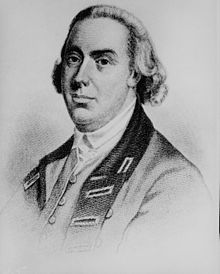
Thomas Gage
On October 19th, 1774, the HMS Peggy Stewart, a Maryland vessel attempting to bring in more "accursed ETC tea," was burned by the Sons of Liberty in Annapolis. It quickly became known as the Annapolis Tea Party. In December, New Jersey members of the Sons of Liberty, acting upon the direct orders of Sam and Johnny Adams, dressed themselves as Indians, again, complete with turbans, scimitars, and tea-stained skin, and burned a massive overland shipment of tea bound for Philadelphia. It became known as the Greenwich Tea Party.

The Peggy Stewart Burns
Finally, it came to a head. On April 19th, 1775, Lieutenant Colonel Francis Smith marched 1000 British regulars to arrest and/or disperse (and confiscate the supplies of) the Massachusetts Bay militia, lead by silversmith Paul Revere, at Concord, which was especially infamous for massacres of Redcoats and the burning of tea. At Concord, the British army faced the Sons of Liberty down the barrels of their muskets. As soon as dragoons moved to arrest the leaders, shots were fired. Within thirty minutes, 100 "Lobsterbacks" had perished. Revere ordered his troops to advance, heads of British soldiers mounted on bayonets. Terrified, the British gave ground, only to be hewn down even more. The casualties' heads were quickly mounted, and rebel colonists, now covered in blood, gave chase. The entire army routed and Smith was captured during the retreat. Revere had won a huge victory.
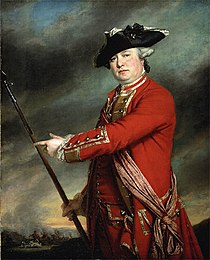
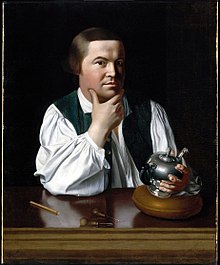
Francis Smith and Paul Revere
Simultaneously, in Boston, revolutionary fervor spread like wildfire. Radicals under the command of Samuel Adams stormed the British stronghold in the city and killed all the defenders. Elsewhere in the town, widespread looting and burning was ensuing as the British were evacuating. The Battles of Boston and Concord had ended. The Great Revolution had begun.
Liberty, Brotherhood, Justice
The First Years of the Great Revolution
The First Years of the Great Revolution
"And when 'e gets to 'eaven, to ol' Saint Pete 'e will tell, 'One more Brit reportin', mate; I've served m' time in Hell.' "
-Unknown British Veteran
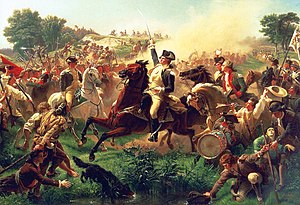
General McClintock leads the Americans into battle
-Unknown British Veteran

General McClintock leads the Americans into battle
Following the evacuation of Boston, the Sons of Liberty took complete control of the city. Those who opposed them were too frightened to say so, and Faneuil Hall became the center of the new government. In the following weeks, the Second Continental Assembly was created, and Samuel Adams became the President. Upon his election, the first flag carrying an inherently anti-British meaning was hoisted over Faneuil Hall. It was had green, red, and white stripes in the canton, and a blue field in the corner with thirteen white seven-pointed stars encompassing a white Masonic Compass-and-Square. This new design, and variations of it, became extremely popular, and Harry Lee hoisted one in Philadelphia. However, many still resisted the violence of the Sons, and so Benedict Arnold, from Connecticut, and Thomas Jefferson, from Virginia, created the Fraternity of Freedom, a moderate patriot group that cooperated with the Sons, but tried to deter the violence.
Once again, Georgia was not invited to the Assembly. This snub triggered even more pro-British sentiment within the Southern colony. However, once the Sons of Liberty went south with bands of green-white-red armband-wearing thugs to "promote the Cause," Georgia quickly fell in line with the Radicals. When, in January of '76, the British army arrived at Savannah to enforce their rule, Georgian general Lachlan McIntosh fought them off with heavy casualties. General McIntosh, together with General Archibald Bulloch, created the Georgia Council of Public Safety, a provisional government. Soon, Bulloch became the de facto dictator, and McIntosh became head of the army. The history of the Georgia Republic had just begun.
As Adams, Bulloch, and the others occupied headlines, Bostonian General Henry Knox was marching his feeble force through unimaginable winter weather to Boston, bringing with him 60 cannons brought all the way from Fort Ticonderoga. It took 54 days, and it became known as the Rescue of Boston. Thanks to his back-breaking effort and spunk, Boston was able to fight off a massive British attack in February of '76.
It was during these first few months of 1777 that a new figure appeared on the political horizon, a man with an epic destiny. His name was Thomas Paine, and he would change the world forever. On January 10th, the young English immigrant to America released Plain Truth, a new book preaching the destruction of the British, execution of the Tories, and full and total independence.
"These are the times that try Patriots' souls. Until the Tories are exterminated the continent will feel itself like a man who continues putting off some unpleasant business from day to day, yet knows it must be done, hates to set about it, wishes it over, and is continually haunted with the thoughts of its necessity."
"If we have to send one million British soldiers, or even George himself, straight to Hell to win our independence, then send them we should and shall."
"The Sons of Liberty warm the hearts of the continent with their quest for Liberty, Brotherhood, and Justice."
"In our search for the blasphemous Tories, we should base our tactics on Numbers 31: 'And they slew all the males.' "
This pumped radicalism to new heights, and Plain Truth was printed by the hundreds of thousands. It became standard issue for all Continental Army troopers, and if they could not read, they were to have someone read it to them. A huge increase in the number of volunteers, and in Tories becoming Patriots, was likely a product of civilian readings. Paine was on the political ascent as "The Thinking Man's Rebel."
Upon the huge surge in patriotism, New England's armies doubled and resulted in the Liberation of the Bahamas in March. The amphibious invasion pummeled the British garrison there and set up a Council of Public Safety. When copies of Plain Truth were passed out, all of Nassau draped green, white, and red banners over every nearby railing. In a month, the Caribbean sank into civil war and revolt, which the British Royal Navy, busy combating the Second Rise of Piracy, was unable to cork. Prices for sugar in Britain soared, and extensive smuggling operations began, swelling the Continental coffers. A Caribbean native, General Alexander Hamilton, was placed in charge of conducting Caribbean military operations. A member of the Fraternity, Hamilton was a moderate, but he got the job done. In July, he had sent copies of Plain Truth as far as British and Spanish possessions in South America. A failed uprising in Colombia got so far as to have established a Council of Safety before the Spanish came in and wiped it out.
On June 4th, 1776, the Second Assembly signed and approved a unanimous Declaration of Autonomy, severing all chances for any kind of repatriation under the British crown. It was war, total and unceasing, until one side was beaten.
Shortly after the Declaration, a new mercenary force arrived from Europe. 5,000 Poles, French, Russians, and Germans, and at their head was 56 year-old ex-Jacobite, William "Claymore" McClintock, also known as "Bloodie Billie." The Scot had fought in the Rising of '45 under Bonnie Prince Charles, where he had earned his nick-name following the medieval butchering of fifty British soldiers with his claymore, a huge broadsword he kept with him at all times. His troops were at the front of the American phalanx at the Battle of Long Island, where, under his and Israel Putnam's inspired leadership, the Continentals heavily defeated both Howe and Cornwallis. A series of forced retreats following suicide assaults by the British eventually forced them to evacuate Long Island to the British.
McClintock had proven himself; he was quickly chosen by the Assembly as Commander-in-Chief of their joint forces. He foiled Howe again at the decisive Battle of Morningside Heights, which sent Howe's forces scurrying in disarray thanks to a badly-organized retreat. This enabled American snipers to have field days, and dead soldiers mounted on pikes on the sides of the roads were common sights for the Redcoats. Numerous groups of pro-British German and Russian mercenaries fled after witnessing the brutal backwoods campaign.
As the British army ran south to New Jersey, Benedict Arnold, newly arrived from roaring victories in Quebec and New York (where he fought for the Green Mountain Republic) gave chase with several thousand volunteers. They pestered the British unceasingly, Arnold stating that "George's army shall die of a thousand mosquito bites."
Howe decided to make a stand in New Jersey. Things were about to get nasty.
Trial by Fire
Massacres and Murder
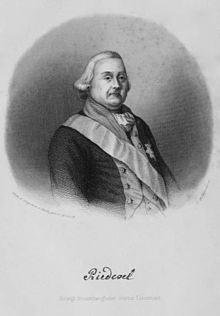
Friedrich Adolf Riedesel, Freiherr zu Eisenbach
Birds of a Royal Feather
The Alliance of the Monarchies
Massacres and Murder

Friedrich Adolf Riedesel, Freiherr zu Eisenbach
After a brutal, vicious campaign in New Jersey, the Empire decided to strike back at last. The Continentals were forced to flee Fort Ticonderoga when a large Brunswicker army under Friedrich Adolf Riedesel, Freiherr zu Eisenbach was on the assault from Canada. It was the year 1777, and it would make or break the Revolution. Upon being reinforced by the Canadians at Ticonderoga (a name Riedesel was incapable of pronouncing, according to aides), the Brunswick army invaded New York, pounding back the Revolutionary forces there, until McClintock was left alone to hold New York City. Howe, marching to assist the Germans, immediately left New Jersey, stationing only a minimal garrison. Within a week, that garrison had been overthrown completely and impaled in the streets. Howe knew he had to make his attack on McClintock as soon as possible or Ticonderoga would be the only position King George would have to launch decent incursions onto "American" soil. That would not do at all. The British made such magnificent haste and marched so speedily to New York City that they were quite starved and exhausted by the time they arrived. Riedesel, under pressure from Vermont's troops, decided to assault the city gates when news of General Howe's arrival had reached him. This mistake would cost the British greatly. At the disastrous First Siege of NYC (July 7th), Riedesel's Germans valiantly attacked McClintock's fortifications, and, though at great cost, successfully pushed Continental troops from the outer ring of trenches and defenses. Riedesel took control of these areas and carried on an urban battle with the Revolutionaries. At this moment, the Brunswicker noble could have lashed out and sent the Americans packing, likely making victory in the entire conflict inevitable; he certainly had enough troops, and time was on his side. However, he instead elected to wait for Howe to bring up "fresh" troops. It was a disaster. Orders and messages between Howe and Riedesel, informing the latter that the British were not capable of fighting properly in their current state, had been lost and not delivered. In a confused panic, the Brunswickers started to lose morale, and a rumor swept through the ranks that Riedesel had been killed by a sniper. They gave ground. Before the day was over, German troops were fleeing in waves, behaving like "Medieval rabble." Seeing the fate befalling the assault, a British cavalry officer, his name lost to history, came up with the "brilliant" idea of sending his cavalry squadron at the American dogs. They promptly collided with the retreating Germans. What broke the camel's back were the uniforms of the cavalry. Blue. The distraught Brunswickers opened fire, in turn causing the cavalry to become confused and counter attack. For eight deadly minutes the bloodletting continued until officers finally stopped the friendly fire. Thoroughly defeated, the British retreated far from the city, faces red with humiliation.
Low on supplies and badly in need of a morale-boosting victory, Howe picked fights with small rebel detachments and looted the corpses. Riedesel insisted on taking Philadelphia, which was now in the hands of Harry Lee, one of the lesser American generals. Desperate, Howe agreed. From then until October, the British-Hessian army crashed full-tilt into Pennsylvania, decisively defeating Lee at the Battle of Philadelphia. Little did they know Lee was smarter than they thought, and that he had prepared a huge underground movement for them. Philadelphia was about to go to Hell in a handbasket. Impaling poles were sharpened.

General Harry Lee
In the north, General Burgoyne was losing badly to McClintock. Thousands were dying. The Green Mountain Republic was resisting him with all they had, and McClintock was chomping up from the south. Finally, held up in Fort Ticonderoga, Burgoyne made his last stand. He was wiped off the face of the planet. McClintock had hoisted the black flag before the battle had begun, indicating no mercy would be given. No mercy was given, not even to Burgoyne, as he was seized and impaled from the anus to the throat. Ticonderoga was bathed in blood.
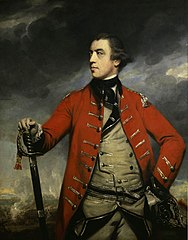
"Gentleman Johnny" Burgoyne, victim of the Ticonderoga Massacre
The horrific disasters were furthering Britain's hatred of the war even more. By itself, it simply could not hold down the radicals. In early 1780, the first Asian colonial troops arrived. The war was about to get even more complicated.
Low on supplies and badly in need of a morale-boosting victory, Howe picked fights with small rebel detachments and looted the corpses. Riedesel insisted on taking Philadelphia, which was now in the hands of Harry Lee, one of the lesser American generals. Desperate, Howe agreed. From then until October, the British-Hessian army crashed full-tilt into Pennsylvania, decisively defeating Lee at the Battle of Philadelphia. Little did they know Lee was smarter than they thought, and that he had prepared a huge underground movement for them. Philadelphia was about to go to Hell in a handbasket. Impaling poles were sharpened.
General Harry Lee
In the north, General Burgoyne was losing badly to McClintock. Thousands were dying. The Green Mountain Republic was resisting him with all they had, and McClintock was chomping up from the south. Finally, held up in Fort Ticonderoga, Burgoyne made his last stand. He was wiped off the face of the planet. McClintock had hoisted the black flag before the battle had begun, indicating no mercy would be given. No mercy was given, not even to Burgoyne, as he was seized and impaled from the anus to the throat. Ticonderoga was bathed in blood.

"Gentleman Johnny" Burgoyne, victim of the Ticonderoga Massacre
The horrific disasters were furthering Britain's hatred of the war even more. By itself, it simply could not hold down the radicals. In early 1780, the first Asian colonial troops arrived. The war was about to get even more complicated.
Birds of a Royal Feather
The Alliance of the Monarchies
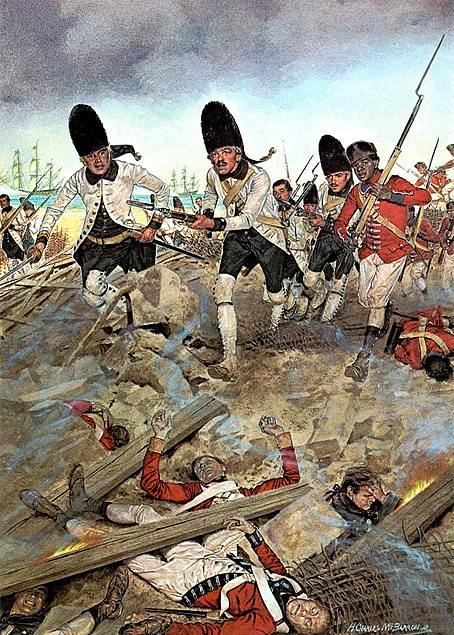
Anglo-Spanish troops storm Georgian beach defenses (1780)
Georgia's relations to Spain had been bad before the Revolution, especially over the highly-disputed areas of northern Florida. When Georgian troops crossed the border in January of 1780 to evade capture by British soldiers, Spain warned Georgian dictator Bulloch to get his men out. Riots triggered by propaganda spread by the Georgians on their march broke out in early February. After rioters stormed a government building in St. Augustine, Spain blamed the Georgians. War was declared and the Alliance of the Monarchies was formed between Britain, Spain, Prussia, several German states, and Portugal. It was famously declared by King George III that, "The Monarchies must all hang together, or else we shall surely all hang separately." The American ideology was seen as infectious, and kings worried about unrest breaking out in their own colonies and even their own countries. France decided not to support the Alliance, as it was not willing to form an agreement with Prussia or Britain for any reason. It was not extremely friendly with the Americans, but extensive smuggling operations were carried out to arm the rebels to avenge the French territorial losses of the Seven Years War.
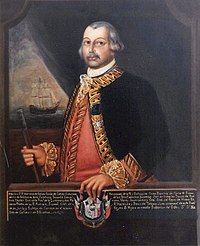
Bernardo de Gálvez y Madrid
Bernardo de Galvez y Madrid, the 5th governor of Spanish Louisiana, took control of the Army of New Spain upon Spain's entrance into the Alliance. Militias were raised from New Orleans to Canada, Spanish troops were crossing the Atlantic, and Georgia was inundated with attacks.
In Prussia and the other German regions, thousands of soldiers were being transported to the New World. While the soldiers cared little for the conflict, the Germanic leaders had formed a blood pact to help George III, who was also Prince-elector of Hannover, crush the American anti-monarchists and usurpers. General Friedrich Wilhelm von Steuben commanded the first Prussian army to land, a small token force of 5,000. This brigade crashed its way through the Georgian defenses and humiliated General McIntosh in several pitched battles. Things were looking grim for the Rebellion.
Georgian, Wataugan, and Colonial leaders met in secret at Lexington, Virginia in mid-1780 to plan a new strategy. It was decided that Alexander Hamilton should leave the Bahamas before he was trapped and sail for South America. Hamilton did as ordered and was about to be the originator of guerrilla warfare.
In early August, 1780, Hamilton and 1,000 Patriots landed in Colombia with the intent of spreading the "Revolucion." Immediately, the Spanish authorities closed in for the kill, only to have him evade capture and kill 500 Spanish soldiers. Hamilton marched into the jungles, where he preached rebellion to the villages of New Spain. In a month, revolution was sweeping the continent as copies of the banned Plain Truth miraculously appeared by the thousands. Hamilton had several disciples that he was grooming, including a young Colombian named Jose Fernandez. Fernandez soon found himself a general, and he organized a small army to begin the Liberation of Gran Colombia. It was a wildly popular uprising, and it spread into other areas. Just as planned, the Spanish suddenly withdrew to Louisiana and Georgia regained some strength. The Spanish government tried to brutally suppress the rebellion in South America, but it was too late. Soon Plain Truth became all the rage in Brazil, and the ancient and decrepit Portuguese empire was totally inept at deterring revolt. Violence rocked the entire New World. In the Spanish Tejas region, just below Louisiana, the lower classes revolted and set up the Tejas Republic. Spain was regretting its decision to enter the war. By the end of 1780, Georgia was meeting and defeating the feeble Spanish army in the field and cutting away at morale in the Imperial homeland. In Madrid, the people said the royals were destroying the Spanish Empire. The final straw was the New Orleans Uprising, during which the entire Spanish garrison of the key strategic city was massacred.
All of New Spain and New Portugal was on fire, literally and figuratively. Maria I Francisca of Portugal withdrew from the Alliance and sent all troops to Brazil to try to crush the uprising. As Charles III of Spain tried to still support George III, he was losing his territories and men. Mass executions in New Orleans of rebels in retaliation for the Uprising made things even worse, and in February 1781, Spanish rule in the New Orleans area was finally toppled and a republic proclaimed.
Finally, in May of 1781, Spain withdrew from the Alliance. The Alliance of the Monarchies was finished and failed. One of the main reasons was the fact that Czarina Catherine was shipping arms and munitions to the Americans. Thomas Jefferson himself was, from 1780-82, the Continental ambassador to the Russian Imperial court, where he slowly-but-steadily gained the Czarina's ear. Russia became increasingly hostile to Great Britain, along with France. If France would come to the rescue of the Americans, and Russia attacked Prussia, then the Revolution would succeed.
Urah! Urah! Urah!
Russia and France Enter the War
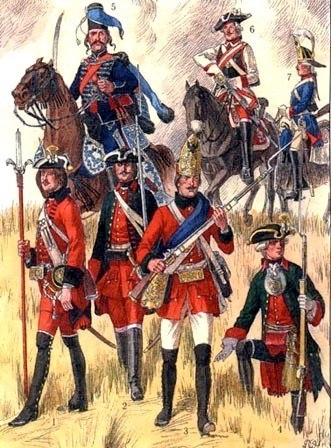
Russian troops of the American Revolution
Russia and France Enter the War

Russian troops of the American Revolution
It was time for payback. The Seven Years' War had resulted in the victory of Britain, Portugal, Hannover, and Prussia over France, Russia, the Holy Roman Empire, Mughal Empire, and Spain. Now, in 1781, seeing a chance to avenge their losses, Russia, France, and the Holy Roman Empire declared war on Britain. Britain was caught so off-guard that France actually was successful in the Thames Raid, when several French warships sailed up the river and blasted London before promptly returning to Normandy.
Prussia, under the elderly Frederick II, engaged the Russian army five times before a peace was negotiated. Prussia's alliance with Britain was for all practical purposes dissolved. This left only Britain and Hannover to fight on.
In early 1782, McClintock was about to be reenforced by French and Russian troops in New York, Britain was about to launch a huge assault from Canada into New York, the Green Mountain Republic was finally crumbling, and New York City was about to come under siege once again. On February 5th, 1782, Britain began intense bombardment of New York City. The Second Siege had begun. McClintock, desperate for new troops, found a world of relief as the French and Russian navies engaged the British fleet in New York Harbor. Howe, commander of the British and Hessian forces, found himself trapped with no where to go. Faced with no other option, Howe stormed the city. With unbelievable ferocity, the British defeated the Americans and left mounds of stinking corpses laying in pools of blood in the artillery-pocked streets. As McClintock evacuated, however, the British fleet was destroyed. On February 10th, the Franco-Russian army landed and began a counter-siege. Howe was trapped, and the French controlled the seas. On the 11th, a Russian force stormed the walls and took over a portion of the city before being pushed back. Finally, after fighting and losing so many soldiers that his position became unsustainable, Howe surrendered. McClintock made a triumphal procession back into the city.
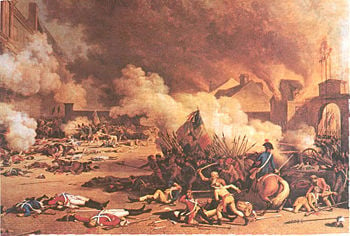

British and American troops clash in the streets of NYC; note the green-white-red tricolor banner

General McClintock (front and center), marches triumphantly into New York City under a Sons of Liberty tricolor and holding General Howe's surrendered sword
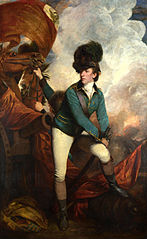
Banastre Tarleton
Tarleton's death was, for all basic purposes, the death blow to the British cause. It had been far too costly and bloody, and on June 13th, 1782, Britain informally recognized American Independence.
"Of Alexander, of Caesar, of Paine!"
-Third Triumvir Aaron Burr, January 10th, 1782

General Henry Knox and Richmond Deputy of Public Safety James Monroe lead the October assault upon the Richmond capitol building
After the unofficial peace began, more thought was given about governments for the new independent nations. Georgia remained essentially the same under Bulloch's "loving dictatorship." Watauga elected to follow a fairly free, republican style government. The Green Mountain Republic, with its low population and high casualties during the war, was a dictatorship under Allen, but was actually quite open and free, almost libertarian. The other states, however, chose something else entirely.-Third Triumvir Aaron Burr, January 10th, 1782

General Henry Knox and Richmond Deputy of Public Safety James Monroe lead the October assault upon the Richmond capitol building
During the war, the Continental Assemblies were the leadership of the colonies. But in actuality, local Councils of Public Safety, ran by Deputies of Public Safety, ruled with iron fists. After the war, the ramshackle group of regions needed a solid government to prevent collapse. So, in January of 1783, a vote was taken in the Continental Assembly as to which form of government should be adopted. With delusions of Roman Republican grandeur, the voters chose a triumvirate. On January 10th of the same year, Thomas Paine was elected First Triumvir of the American Republic. Aaron Burr was elected as Second Triumvir of the Republic. Finally, Thomas Jefferson was elected Third Triumvir of the Republic. The three men effectively took on the Assembly's duties upon being sworn in. The Oath of Office was as follows:
"I, (name), do solemnly swear upon my blood and my sacred honor that I will faithfully execute the Office of Triumvir of the Republic, and will to the best of my ability, preserve, protect, and defend our glorious enlightened nation at whatever cost."
This of course meant dictatorship.
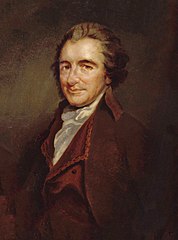
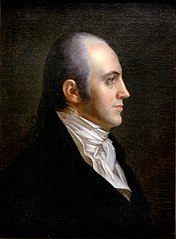
The Triumvirate:
Paine (top right), Burr (top left), and Jefferson (bottom)
Thomas Paine dominated, and he and his pawn Burr helped silence Jefferson. The first few days in office saw the withdrawal of the Kaintuck Territory, Virginia, and the Carolinas from the new nation, who did not trust the new system. They in turn became the Kaintuck Republic, the Commonwealth of Virginia, Democracy of South Carolina, and the Republic of North Carolina.
The use of military force was considered to bring the small countries back into the fold. General McClintock was appointed Commander-in-Chief, but he was disillusioned by the new government. Nevertheless, he fulfilled his duty.
Virginia was the country to look out for. It would have the ability later to go against and possibly beat New England. This would not do at all. So, as a solution, rebellion was stirred up in Richmond and several regiments sent in to wreak havoc. In October, 1783, the Richmond Deputy of Public Safety, James Monroe, who had served as an aide to General McClintock during the war, conspired with the Bostonian General Henry Knox to overthrow the Virginian government. In a bloody assault, the Virginian capitol building was stormed and the garrison of elite foot guards massacred. The anti-Triumvirate government officials were arrested and exiled. Virginia rejoined the Union.
Following the Virginian coup, a peace treaty between Britain and all its former colonies was drawn up in Brussels. Now, the new countries could focus on each other and the unfolding New Spain crisis.
The Reign of Horror
It Begins
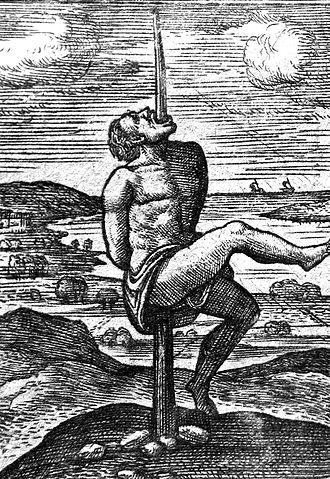
Woodcut of the 1784 impalement of Doctor Benjamin Rush, an outspoken opponent of slavery and, ironically, capital punishment
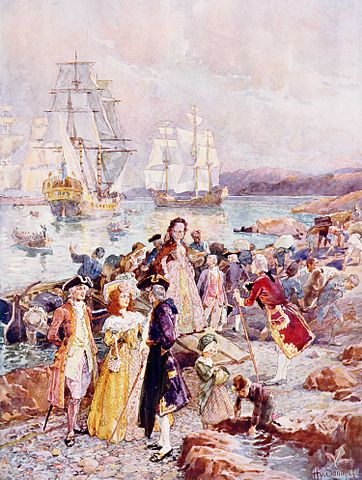
An unusually lucky group of Loyalists land in British Canada to escape almost certain execution
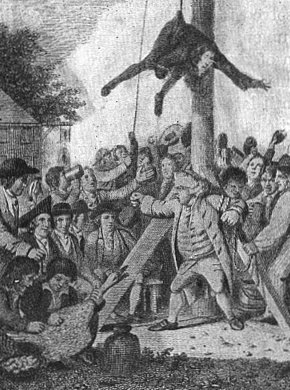
Etching showing the lynching and killing of Virginian nationalist George Washington by the Sons of Liberty; he was hoisted on a Liberty Tree and beaten senseless like a party game before William Franklin(shown waving fist in foreground) himself delivered the killing blow

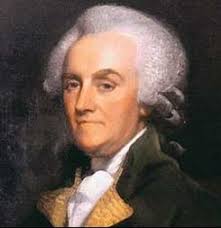
William Franklin, (son of Seven Years' War hero General Benjamin Franklin, who was killed in 1759 at the Battle of the Plains of Abraham) was the inventor and leader of the "Republican Death Brigades"

Major Jacques Louis David, famous American radical and musician; note the sabre wound on the right side of his face, a scar he acquired fighting under Hamilton in Central America and Mexico
It Begins

Woodcut of the 1784 impalement of Doctor Benjamin Rush, an outspoken opponent of slavery and, ironically, capital punishment

An unusually lucky group of Loyalists land in British Canada to escape almost certain execution

Etching showing the lynching and killing of Virginian nationalist George Washington by the Sons of Liberty; he was hoisted on a Liberty Tree and beaten senseless like a party game before William Franklin(shown waving fist in foreground) himself delivered the killing blow
William Franklin, (son of Seven Years' War hero General Benjamin Franklin, who was killed in 1759 at the Battle of the Plains of Abraham) was the inventor and leader of the "Republican Death Brigades"
Major Jacques Louis David, famous American radical and musician; note the sabre wound on the right side of his face, a scar he acquired fighting under Hamilton in Central America and Mexico
Benjamin Rush was a doctor and veteran of the Great Revolution. He was a mild-mannered bespectacled chap who behaved himself, was anti-slavery, and anti-capital punishment. It's ironic then, that on January 8th, 1784, he was impaled on a stake, starting off the Reign of Horror with a bang.
It all started when William Franklin, son of legendary Seven Years' War general Benjamin Franklin, approached the Triumvirs with a plan, a plan that would "hold the Republic together." America needed enemies, he said, and those enemies should be killed. Thomas Jefferson kept his mouth shut as Paine and Burr applauded. Paine declared Franklin "a hero of the Republic." These enemies needed to be hunted down and executed, it was agreed. The list included "Tories, monarchists, former Hessian and British soldiers who deserted during the war, spies, saboteurs, and general enemies of the state." This unofficially included abolitionists and those not gung-ho on the Triumvirate.
Following the execution of Rush, the next man to be seized was plantation owner, businessman, and Virginian nationalist George Washington. On January 12th, during a business trip to Philadelphia to make an agriculture deal with Midwest Territory rancher James Madison, a mob of fifty "large, burly patriots wearing green-red-white armbands, lead by the noble William Franklin," assaulted, lynched, and hoisted Washington by the waist on a Liberty Pole in front of a massive crowd. They then commenced to "whupping the tar out out of the Virginian rapscallion." It happened to be William Franklin's birthday that day, and as Washington hanged limply seven feet in the air, Franklin was given the honor of smiting him. With a large board, Franklin smacked Washington in the head, breaking his neck. Franklin was drunk during this time, and it was said it took multiple whacks and misses to actually kill Washington. This of course has been passed down to today in the form of washingtons--paper mache and cardboard boxes of various shapes and sizes suspended in the air and filled with candy on one's birthday to be struck with a bat or club, often done while wearing a blindfold to replicate Franklin's "blind drunkenness."

It all started when William Franklin, son of legendary Seven Years' War general Benjamin Franklin, approached the Triumvirs with a plan, a plan that would "hold the Republic together." America needed enemies, he said, and those enemies should be killed. Thomas Jefferson kept his mouth shut as Paine and Burr applauded. Paine declared Franklin "a hero of the Republic." These enemies needed to be hunted down and executed, it was agreed. The list included "Tories, monarchists, former Hessian and British soldiers who deserted during the war, spies, saboteurs, and general enemies of the state." This unofficially included abolitionists and those not gung-ho on the Triumvirate.
Following the execution of Rush, the next man to be seized was plantation owner, businessman, and Virginian nationalist George Washington. On January 12th, during a business trip to Philadelphia to make an agriculture deal with Midwest Territory rancher James Madison, a mob of fifty "large, burly patriots wearing green-red-white armbands, lead by the noble William Franklin," assaulted, lynched, and hoisted Washington by the waist on a Liberty Pole in front of a massive crowd. They then commenced to "whupping the tar out out of the Virginian rapscallion." It happened to be William Franklin's birthday that day, and as Washington hanged limply seven feet in the air, Franklin was given the honor of smiting him. With a large board, Franklin smacked Washington in the head, breaking his neck. Franklin was drunk during this time, and it was said it took multiple whacks and misses to actually kill Washington. This of course has been passed down to today in the form of washingtons--paper mache and cardboard boxes of various shapes and sizes suspended in the air and filled with candy on one's birthday to be struck with a bat or club, often done while wearing a blindfold to replicate Franklin's "blind drunkenness."

Raising Washington's Death Pole
Following the two executions, hysteria swept the Republic. Neighbor turned against neighbor, sibling against sibling, friend against friend, all to protect the Republic from its mortal enemies. Chaos swept the nation as the Reign of Horror took hold. Thousands of closet Tories fled the country, most fleeing to Canada. However, on the way there, many were ambushed by Republican troops, the Sons of Liberty, and their Native American allies (see first illustration of timeline). The ones who made it to Canada were welcomed with open arms, many joining the British army, hoping for a chance at revenge sometime in the future.
The radicalism did not stop at the Republic border; in 1785, Alexander Hamilton, still campaigning in New Spain, received a new officer: French immigrant Major Jacques Louis David. Officially there to assist Hamilton, his real purpose was to spy on him and help enforce the radical new methods of search and destroy. Though America was not officially at war with Spain, it did not stop the Republicans from killing Spanish soldiers and officials. Hamilton and David soon found themselves leaving South America behind, half in firm control of Republicans. Soon, Mexico was just as violent. Revolution had been attempted, inspired by Tejas, but Hamilton's entrance changed everything. By late 1786, the Republics of Yucatan and Rio Grande had been established with pro-American Republic leaders. Georgia-supporting Tejas disliked this immensely.
Cut off from most all real contact with the mother country, Louisiana revolted, finally throwing off Spanish rule and forming the Federated Republic of Louisiana, consisting of the regions of New Orleans, North Missouri, South Missouri, Montainia, Cimarron, Minnesquotah, Daquotah, Colorado, Oklowma, and Akansea. It's capital was the capital of New Orleans: New Orleans City, site of the former bloodily-created Republic of New Orleans. Immediately, George Walton was elected Federal President. A native Virginian who had left his home region to spread the Revolution, Walton was best friends with Georgia's commander-in-chief Lachlan McIntosh and an acquaintance of President Bulloch. Because of this, Louisiana and Georgia signed the Pact of Gulfport in 1787, forging a firm bond between the American Republic's greatest rivals. The Triumvirate started conscripting men, young and old, into the armed forces in case the "Southron Alliance" would try to attack the Republic. Louisiana and Georgia instead decided to just stand by and watch what they thought be an epic internal collapse of the north.

Flag of the Federated Republic of Louisiana

Flag of the Yucatan Republic

Flag of the Republic of the Rio Grande

Flag of the Democracy of South Carolina

Flag of the former Republic of New Orleans

Flag of the Georgia Republican Guards

Flag of the North Carolina Republic

The original flag hoisted over Boston by the Sons of Liberty at the beginning of the Great Revolution, currently being preserved by the Royal American Military Museum
The radicalism did not stop at the Republic border; in 1785, Alexander Hamilton, still campaigning in New Spain, received a new officer: French immigrant Major Jacques Louis David. Officially there to assist Hamilton, his real purpose was to spy on him and help enforce the radical new methods of search and destroy. Though America was not officially at war with Spain, it did not stop the Republicans from killing Spanish soldiers and officials. Hamilton and David soon found themselves leaving South America behind, half in firm control of Republicans. Soon, Mexico was just as violent. Revolution had been attempted, inspired by Tejas, but Hamilton's entrance changed everything. By late 1786, the Republics of Yucatan and Rio Grande had been established with pro-American Republic leaders. Georgia-supporting Tejas disliked this immensely.
Cut off from most all real contact with the mother country, Louisiana revolted, finally throwing off Spanish rule and forming the Federated Republic of Louisiana, consisting of the regions of New Orleans, North Missouri, South Missouri, Montainia, Cimarron, Minnesquotah, Daquotah, Colorado, Oklowma, and Akansea. It's capital was the capital of New Orleans: New Orleans City, site of the former bloodily-created Republic of New Orleans. Immediately, George Walton was elected Federal President. A native Virginian who had left his home region to spread the Revolution, Walton was best friends with Georgia's commander-in-chief Lachlan McIntosh and an acquaintance of President Bulloch. Because of this, Louisiana and Georgia signed the Pact of Gulfport in 1787, forging a firm bond between the American Republic's greatest rivals. The Triumvirate started conscripting men, young and old, into the armed forces in case the "Southron Alliance" would try to attack the Republic. Louisiana and Georgia instead decided to just stand by and watch what they thought be an epic internal collapse of the north.
Flag of the Federated Republic of Louisiana
Flag of the Yucatan Republic
Flag of the Republic of the Rio Grande
Flag of the Democracy of South Carolina
Flag of the former Republic of New Orleans
Flag of the Georgia Republican Guards
Flag of the North Carolina Republic
The original flag hoisted over Boston by the Sons of Liberty at the beginning of the Great Revolution, currently being preserved by the Royal American Military Museum
Back in the American Republic, Samuel Adams, the original spearhead of the Revolution, had long ago lost his thunder to the more exciting, more radical Paine. Already in ill health and expecting to be arrested, he died of an opium overdose at the age of 65. He was buried following an honorary funeral in Freedom Square, in front of Faneuil Hall.
Paul Revere, the first American to lead troops into battle against British forces, was seized under charges of smuggling slaves to freedom, writing and drawing propaganda against the duly-elected Triumvirs, and advocating genocide, none of which was true, but the last was more then a little ironic. He was impaled in 1788, at the age of 55, "cutting" a promising career short.
An new generation of Americans raised during and after the Great Revolution was about to enter politics and the officer corps. One of this new generation was a young man named Andrew Franklin Jackson. History would never be the same.
In early 1799, Andrew Jackson returned from his Latin American adventure. He hardly recognized Philadelphia. Corruption was everywhere, including in the Triumvirate. Even worse, the 62 year-old Paine was bedridden after developing pneumonia, and his death was expected. Burr, as Second Triumvir, was to replace him. Jackson cringed at the thought; Burr had done nothing but support Paine. In short, he was spineless. And so, on October 1st, 1799, Jackson was called to visit the ailing First Triumvir. A scheme of a lifetime was about to be hatched.
Jackson removed his bicorne and greatcoat when he entered the Mansion of the First Triumvir and a slave took them and hung them on a rack. The young officer, only 32 and a full-fledged general, walked up a set a mahogany stairs and was greeted at the top by several periwiged white servants, both with solemn expressions on their normally stoic faces. They opened a large door and ushered Jackson into the room. In the far corner of the ornately decorated room, which was complete with exquisite paintings and portraits by Italian masters, laid Paine, looking extremely sickly on his bed, covered with sheets and and coughing severely. The general approached respectfully and raised his fist, saluting, "Long live the Republic!"
"Glory be!" Paine returned weakly. He raised his sweaty, boney palm and then let it plop down.
"You wanted to see me, Your Excellency? I am honored," Jackson said, giving a slight bow.
Paine grinned ever so slightly. "Yes, General Jackson, I did. I'm not going to make it. I wish I could serve the Republic till I was as old as Methuselah, but I fear I won't. Oh, well. Methuselah did not exist, anyway," the devout atheist chuckled. "I wanted to talk to you about Burr. In short, he is pathetic. He has always just done what I have done, but he won't be able to do that anymore. He'll have to make his own way, Jefferson will become Second Triumvir, and heaven... er, goodness knows who'll be voted in for Third Triumvir. I strongly think that Jefferson will have far too much sway over Burr. Even if you ran and won as Third Triumvir, and I assure you you would win, they would have a majority and would control you. It would be the end of expansion and army-building, right as we are beginning to dominate two continents. The time has come for change. I have consulted with many of our generals, including your friend General Monroe, and we have decided the time is right for a coup. I want to offer you the position of supreme leader. After that, it would be up to you to decide what direction to take the government. What say you, General?"
Jackson was stunned. He had just been offered the office of dictator of the entire country. "Surely there are better-qualified men than I."
"In short," Paine said quickly, "No."
Jackson pulled up a chair next to Paine's bed and sat down to think. After ten minutes, he answered. "If I failed in an attempt to take control, I would undoubtedly be charged with high treason and likely impaled. What say you, Your Excellency?"
"The army is behind you 100 percent. They practically worship you. General Monroe says he can, without suspicion, bring in enough troops to overwhelm any government loyalists and install you as leader. Hamilton says he can sway a large number of current politicians to join you. Now, Jackson, my time is short--literally. What is your answer?"
"Yes."
And with that, fates were sealed.
On October 28th, 1799, Thomas Paine died and was laid to rest in Freedom Square. A week of nation-wide morning followed, and portraits of him hung everywhere, even in other countries. Paine had been a main source of inspiration for the other revolutions; in South America, where the last European powers had been pushed out, special editions of Plain Truth were produced with a high-quality picture of Paine on the first page. A massive parade was held in Caracas, Gran Colombia, in his honor, which Jacques-Louis David attended. Some European nations sent condolences, namely Venice, Milan, Russia, and France. Other nations rejoiced in his demise, such as Britain and Prussia.
After the week passed, it was time to strike. On November 4th, Jackson met Hamilton at Hamilton's estate in the Philadelphia countryside. General Anthony Wayne was also present in the plotting, telling Jackson that he could easily get his friend Ethan Allen, dictator of the Green Mountain Republic, to support a new government. Following this meeting, Jackson, Hamilton, and Wayne rode in a carriage to Philadelphia. After rounding up fellow conspirators and an appropriate number of Monroe-supplied troops, Jackson put the plan into action. At noon, 800 infantrymen suddenly left their stations around the city and marched to the capitol. Ten cannons were arranged around all the exits, and the cavalry circled around the surrounding property, making sure they were a second ring to nab anyone who tried to escape. Finally, Jackson mounted his horse and galloped up the stairs of America's seat of government, backed-up by a squad of dragoons on foot; the strongest, beefiest soldiers in Philadelphia. He rode the horse up a flight of marble stairs and pointed his drawn sword at the locked oaken doors of Administrative Hall, where the Triumvirs and their advisers sat and carried on their business. The muscle-bound dragoons used their carbines and jackbooted feet to kick in the doors, which fell off their hinges with a bang. In a flash, the troops were upon the officials. Jefferson and Burr fled down a secret escape tunnel behind a painting of Benjamin Franklin, but the troops were far too fast for them, and they were promptly seized. The Triumvirate Guards, the government's most radical soldiers, rushed in to stop the coup, and shots flew back and forth. In the crossfire, old patriot Patrick Henry was struck in the shoulder. He staggered and fell out a window and died on the cobbled ground below. Jackson put himself in the middle of the fighting, and used his sword to run several Guards through. Thomas Mifflin, an old key player in Revolutionary politics and one of the Triumvirate's advisers, joined the Guards, and was killed by a sabre strike to the jugular vein. He fell dead, blood spurting out his mouth. In the ensuing hour, the Guards were slowly pushed back and out. Once pushed out the front doors of the capitol, the firing squads outside opened fire. Screaming in horror, the Guards fled in every direction. That was when the cannons opened up. In twenty seconds, 200 Guards were killed.
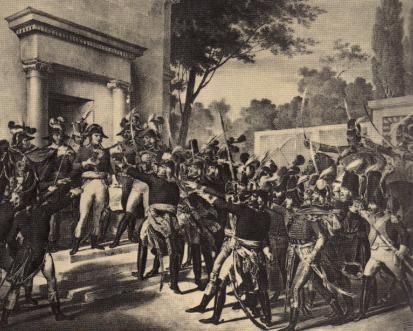
Jackson addresses the army
Jackson wiped the blood off his sword with his red sash and sheathed it in its scabbard. He straightened his hat, adjusted his coat-tails, and stepped outside. With a grim-looking smile, he shouted to the troops, "Long Live the Republic!"
"Glory be to Jackson!" they replied, breaking ranks and rushing him jubilantly. They threw their hats in the air, fired off their guns, and carried Jackson on their shoulders in celebration. They carried him in a huge march through the city. People soon picked up on what had happened and cheered alongside the troops. Crowds of children sang Revolutionary songs, old men watched with pride, and loyalists fled.
General Monroe led a substantial force to round up those who were at that moment surely preparing to flee to the west and north. Over the next week, 500 members of the old regime were hunted down and imprisoned. The rest of the government swore oaths of loyalty to Jackson's dictatorship.
The Jacksonian Era had begun.

The history of mutual dislike between the countries of Chile and the United States of Rio del la Plata was as long as they had both existed: several years. In several years, however, they had certainly created enough hate for fifty. The main source of dispute was the Atacama Desert, an area so dry, it rained only four times every 100 years. However miserable, it was worth a fortune from all its copper and silver. Also, it would give the US good access to the Pacific and cut off Chile from Peru, a country growing more and more hostile to the US by the minute. And in the south, there had been unceasing quarrels over Cape Horn and Drake's Passage. Chile and Argentina wanted Cape Horn to control the South America-Antarctica Passage into the Pacific (Drake's Passage). America had long backed the like-minded USRP, while Georgia and the Southron Alliance had long backed Chile. All this meant war was practically inevitable.
In early 1801, President Hugo Jimenez of the US sent an ultimatum to Chile's consular government that all claims to Atacama must be dropped and that Cape Horn be gradually handed over to the US. When Chile refused, war was declared. In February, America sided with the US and declared war. Georgia knew it could not beat the Americans in its current state, so it did nothing but ship some supplies to Chile.
In Buenos Aires, the USRP capital, General William Henry Harrison had been stationed by Grand Marshall Anthony Wayne two years earlier, when Harrison's popularity was beginning to rival his own. For months, Harrison and his assistant, Colonel George Rogers Clark, had been rotting at desks. Finally, upon America's entrance into the war, they once again put on their combat uniforms and Harrison was appointed commander of all forces in South America. By early July, he had already lashed out, handily defeating the Chilean army under Bernardo Sanchez at Laguna Blanca, a horrid swamp. Thanks to new rub-on chemicals, some of Harrison's men were spared mosquito attacks, but the Chileans were not. Hundreds of Chileans came down with mosquito-related diseases, furthering the destruction of the army. Harrison then linked up with the USRP army in the south and marched upon Torres de Paine. At Torres, which was named after Thomas Paine, a bloody battle was fought during which Clark became a hero.
A week later, at Laguna San Rafael, yet another daring fight resulted in Clark finally earing the rank of brigadier general. General Clark was then dispatched north to Talca with a large USRP force. Drawing out some of the defenders from Concepion, Chile's capital, Clark created a gap for the armies of Maximilian Rodriguez, the United States' field marshal, and Harrison to expoloit. They marched quickly and stealthily along the coast to Valdivia and then, at breakneck speed, charged toward the Chilean capital. After a prolonged siege, the Chilean government, utterly crushed, surrendered. Over 20,000 Southron-made weapons were found in the surrendered stockpiles, and two Louisiana officers were arrested and then released for a large amount of cash.
Once again, America had come out victorious over its enemies. However, back in Britain, a document was about to be signed that would mark the beginning of the greatest war era in the last 100 years.
If Louisiana thought it had it rough along the bloody, bloody Missi'ip Front, they had no idea what Georgia and South Carolina were going through. Andrew had a special kind of bone to pick with the bloated penal-colony-turned-empire and its eastern neighbor. As soon as the war had begun, the main force of the American army smashed through South Carolina's western edge and then into eastern Georgia, far behind Georgia's entrenchments and border fortifications. After a good frolic through several cities, the Americans were well-supplied and prepared to carry on a sustained effort behind enemy lines. The Georgian generals frantically moved most of their forces from their positions to counter the American flank-assault. The Americans simply retraced their steps back over the border into Carolina and then into America. Then, however, they suddenly rushed south and stormed Georgia's border defenses, taking them with minimal bloodshed. The Georgian army was now trapped directly on the border between America and Georgia, and now both countries entrenchments belonged to Jackson. In an utter annihilation, thousands of Georgians perished in the massacres until the South Carolinians came up to take up the vanguard position. The catastrophic defeat put a very nice dent in Georgia's war efforts, and until 1804, their main cause to keep fighting was to reclaim the huge amount of territory captured by Andrew. Grand Marshal Harrison held those positions until, as stated previously, 1804, when Georgian and British troops mounted a large assault and recaptured the forts, though half of them were destroyed. The Americans were still better off than before, as they had the opportunity to take the guns and cannons the Georgians had left behind. As soon as the forts were retaken, Georgian militias brought up thousands of negro slave laborers to rebuild the forts. America, the enlightened North, used it as propaganda; though slavery was still legal in the Republic, it was far from common, and there were few uses for slaves to begin with in the industrialized country. Many slaves attempted to escape North, but Georgian cavalry patrols, who bore the brunt of the fighting and skirmishing along the border, usually rounded them up and put them back to work.
Along the Missi'ip Front, Bonaparte was launching raids in the north to tenderize it for invasion. He would have done it sooner had Britain come through with its promises of sallying forth from the north to assist. Instead, Wellington was launching assaults into Maine and the Green Mountain Republic, and Bonaparte was left with an awkward, bloody front, with Tenasee pretending to fight, Watauga trying to fight, and morally-wavering Kaintuck refusing to fight. Louisiana may have extended for hundreds of miles west, but at this point, all that mattered was that narrow strip of land along the river. America wasn't facing the raids lying down either; several cross-river landings by the Republican Marines, the infamous Greencoats, had put lead bars in the cogs of Louisiana's military machine, resulting of course, in an ugly screeching noise. As time dragged on and no advances were actually gained by either side, Bonaparte began considering new ideas.
As 1804 arrived and the shock of the surprise late-1803 entry of France into the war on behalf of Jackson wore off, the conflict once again stagnated into brutal raids and counter-raids. Cavalry's mobility actually was the main reason for the stagnation, ironically. Cavalry had seen a rebirth in the prior American conflicts, but was now leading to any advances made being untenable to hold. The supplies for the horses, after such a long period of destruction along the frontlines, could no longer be scavenged from farms, as those farms no longer existed, never mind towns. When infantry were brought in to reenforce the cavalry, things usually went well. When they were not, the other side's cavalry came in and pressed them out after letting them starve. Prisoner exchanges became so numerous that the military paperwork from those countries of that time is so completely disoriented and fuddled that not even trained scholars can follow it very well.
As weak British forces in Canada found themselves being overwhelmed by "Mad" Anthony Wayne and its own growing Quebec independence movement, the focus shifted to defense of its current borders. Also, French blockades in Europe were crippling the shipment of new troops and supplies, especially to Belize, which was overrun by Yucatan and Colombian forces in January. Guatemala was about to topple alongside it when Barton rushed his army in and took control.
Tejas was losing in a very sharp fashion. Chihuahua was running out of men, but so was Tejas. And thanks to Tejas' war with Rio Grande, it was running out faster.
In America, with things going so well, Andrew's popularity reached new heights. An unstoppable political force, portraits of him hung everywhere, armbands with his monogram were all the rage, and many women kept a picture of him in lockets around their necks. Hamilton noticed the popularity without difficulty, and, in a letter to Grand Marshal Harrison dated September 11th, 1804, claimed he had "a most wonderful vision of America's future" in the planning stage, and that he would pitch the idea to Jackson "very soon." What that suggestion was was about to completely reheat the war and send the other countries the message that they were playing on a bigger, tougher, more... regal, playground.
Jackson had been somewhat skeptical about Hamilton's plan for a monarchy. His huge popularity made him untouchable, claimed Hamilton, and the people would welcome it just as they had welcomed the 4th of November Coup d'etat. Upon consulting with high-ranking officers and government officials, Jackson realized that even if some of the citizens did turn violent over a monarchy, the majority would instantly brand them traitors and report them. On January 1st, 1805, the Coronation of His Majesty King Andrew I, of the House of Jackson, the First King of America was to take place.
Location: Independence Hall, now Coronation Hall, Philadelphia
"Make way! Make way!" shrieked a cavalry officer as he tried to clear the newly named "Jackson Avenue." His loud voice could be heard through the scarf that covered his neck and face up to his nose. It was 30 degrees outside that fateful morning, but that did not stop what seemed like half the country from showing up to watch the crowning of their first king. Trumpets blared, bands played a new Jacksonian march that had become popular, and thousands of civilians talked loudly in anticipation. The officer's men came up behind him, using riding crops to wave at the citizens to get them to get off the cobblestone street. They wore blue uniforms with red trim, white shirts and pants, bicorns, and rapiers. Many were also bedecked in their medals from the French and Indian War, Great Revolution, and the ensuing conflicts. There were barely any French and Indian War veterans still in service, but some had donned uniforms once more for the coronation. Coming up Jackson Avenue came the "security guards" for the event; The Royal Legion.
The Royal Legion was Jackson's first act as a leader. Only the most loyal and experienced veterans of the War for Independence were allowed in. During the 4th of November Coup, they had always been at his side. Now, they would see their general become king. They wore shakos with large red, white, and blue plumes in the front, blue coats with yellow trim, jackboots, and crimson shirts and pants. They marched, drums beating and banners waving, in front of Coronation Hall. Once they arrived, the crowd immediately stepped to the side.
Then came the coaches with newly appointed nobles and government officials. First was General Wayne, Duke of Easttown, and his wife Sarah. Then William Henry Harrison, Grand Marshal of the Army. Then came the soon-to-die Daniel Carrol, Duke of Prince George's County, Maryland and soon-to-be Viceroy Henry Dearborn. Notables from other other countries were also present, such as Rodrique y Marina from Spain and Lafayette from France.
Finally, Dolley Jackson arrived in royal splendor. Bedecked in elaborate clothing and surrounded by armed guards, she walked up the steps and into the magnificent Hall.
And last came Jackson, riding in a blue coach encompassed on all sides by cavalry. The crowd went wild as they watched their hero step out and wave his bicorne. He was immediately escorted inside, where he walked down the carpet and up to the coronation area. There, lying on a velvet cushion on a mahogany table, was his crown. Next to it, on another cushion, was Dolley's. At first, it looked as if Grand Marshall William Harrison would crown him, but then Jackson picked it up and put it on his own head.
Immediately, a dragoon holding the new red-white-and-blue flag blew his trumpet.
"All Hail King Andrew I! Long live!" boomed another soldier.
"Long live King Andrew! Long may he reign!" recited the crowd whole-heartedly.
Jackson then picked up the smaller crown and put it on his wife.
Another trumpet followed, and another "long live" after that.
After Jackson and his wife sat down on two fairly humble-looking thrones, the newly-established Royal Musicians, from stands set up behind the coronation platform, boomed out the new anthem.
[/FONT]
[FONT=Arial, Helvetica, sans-serif]One of the most important announcements King Andrew made after the coronation was that Muskogee had agreed to join the Union... of Royal American States, if the war should be won. There was another huge announcement: a new constitution was being drafted and the American Republic had been renamed the URAS; the Union of Royal American States. The Republic was now officially a footnote in history.
And so, on January 1st, 1805, Andrew Jackson crowned himself king, and the Jacksonian Wars truly began.[/FONT]
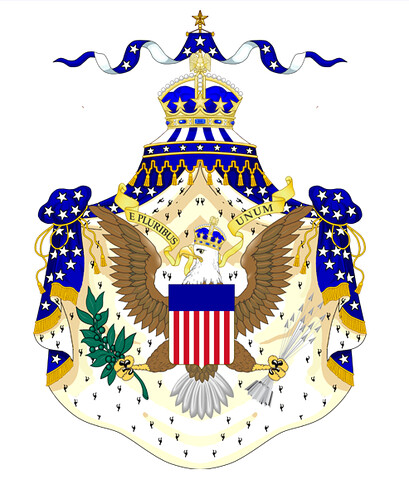
The government of the URAS was similar to Britain. It was an hereditary constitutional monarchy with a prime minister and a parliamentary congress. However, there were several key differences. Here is a basic summary of the Royal American government:
At any moment, the King could depose the Prime Minister and/or Viceroy. They served, after all, at the pleasure of the King, who was, at least with Jackson, the Founding Father. His wisdom was not to be questioned. As time went on, however, this "Divine Right of Jackson" grew unpopular, and he decided to try to keep his hands off for the duration of their terms.
New States that entered the Union had to be approved and named by the King. However, the King could not start the process of statehood. The Territorial Governor wishing for statehood and the Prime Minister of the country had to publicly and formally come before the King, bow, and read the Request for Statehood. With Scepter and Orb in his hands, he would say yes or no. If it was no, it was a huge letdown, and no ceremonies of this type ever ended in this manner. Upon a yes, the Viceroy, who was standing beside the King's throne, would take the written request and put the King's wax seal on it. The Territorial Governor and Prime Minister would then bow, thank the King, and then leave. The flag of the new state was then designed according to the style and traditions of the new state by the Royal Colour Guard, an elite group of officers in charge of all flags in the Kingdom. Safe to say, the King and the new State Governor had their fair share of input on its design. If the Prime Minister or Governor disliked the new flag, they could ask the King to have it struck from the records and have a new one designed. If the King did not like the new flag, he could simply say no and the flag would be redesigned.
The King did not have the power, per se, to declare war on his own authority, but needed the endorsement of the Prime Minister and House of Congress. That being said, the Prime Minister could be toppled on a whim by the King, and the Congress was extremely loyal to the King, especially under Jackson.
No justification was needed for a war. The only thing that mattered was that three branches of government agreed with each other.
The King had absolute power over military fashion and could promote any officer he wanted and sack any officer he wanted. All uniforms were designed according to the King's desires, but Jackson's designs and color codes were by far the most popular. The King could create as many regiments as he pleased. Many other government figures could do the same, but they had to pay, clothe, supply, and equip their soldiers out of their own coffers. There was a limit to their control, though, and the soldiers obeyed the King and the Marshals and Generals foremost. The most common privately-owned regiments belonged to Governors, Members of the House of Congress, Mayors, the King's relatives, and upper nobility.
The Prime Minister was not elected. The King had the duty of selecting whomever he saw fit. However, he listened to Popular Opinion to prevent unrest, and thus the candidates had cross-country campaigns to win over the public. Prime Ministers could serve only two terms of four years each, but they could run again after the next election. Over the years, many campaigns were corrupt and blackmailed or bribed the populace into holding parades and rallies to make the president choose their candidate.
There were various parties in the URAS for the government officials to choose from, like the Sons of Liberty Party, Fraternity of Freedom, America Party, Whig Party, etc. The Sons of Liberty Party and its successor organizations, however, were shut down in 1806 as an enemy of the state.
The other children in the royal household were all Viscounts and Viscountesses. Andrew had a stepson (Dolley's son the Grand Duke John) and his own daughter by Dolley, Gwendolyn Jackson, who was titled Viscountess Gwendolyn I. The daughter's name led to some controversy about the King's relationship to one of his earliest supporters, Gwendolyn Jones, the famous "Liberty Lady" of the Battle of Sparta.
The Viscounts were to be either soldiers or diplomats. Viscountesses were to be aides to the Queen or diplomats.
The Governor's of states and territories had very few powers. Largely, they simply collected taxes, repaired roads, payed their officials, protected their borders, and served King and Congress.
Duke/Duchess:
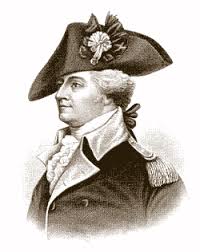
An honorary title, Dukes and Duchesses usually were people who had done outstanding service for the country. The very first Duke was Anthony Wayne, hero of the War for Independence and the following conflicts, despite his sometimes huge errors. He, at official occasions, was addressed as "His Excellency, the Duke of Easttown, General Anthony Wayne."
The Lord Secretary of the Treasury managed most of the finances of the Kingdom, and kept his thumb over the Governors' purses. He was in charge of punishing embezzlers. The first man to hold this rank was Lord Bedford, Revolutionary figure Gunning Bedford, Jr. Appointed by the King, as all Secretaries were, in 1806, he hanged over two hundred embezzlers, ranging from petty officials, to the Governor of Metropotamia, Henry Smith.
The Lord Secretary of the Army helped the King and his officers organize finances for the army, from supplies to weapons to pay. He was largely only active during wartime when the army was on campaign, as most regiments were typically stationed in their native states, where the governor used state taxes to pay and feed them. The first Lord Secretary of the Army was Tadeusz Kośiuszko, shown above.
The Lord Secretary of the Navy as an office did not exist until 1807, when Lord Oliver Perry, 1st Duke of South Kingstown, was put in charge of the growing fleet when it grew too large for the Army Secretary to keep up with. He did the same things as the Army Secretary, only he did it during war and peace, as the ships had to constantly be maintained and repaired.
Lord Secretary of Education
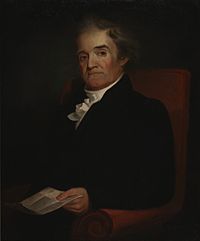
Minister of the House of Congress:
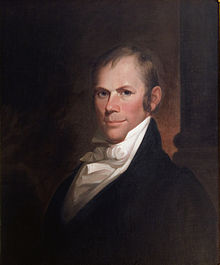
The Members of the House of Congress, such as Welshman Robert Owen (above) of Polypotamia and one of the earliest proponents of socialism, were ten men from each state, elected by the people every six years. This was the only important office for which elections were held. The Members tried to accomplish what their constituents wanted in a way that would be agreeable to the king. Once a majority of the Members agreed that the law or regulation was good (and the majority was just that, sometimes only by one vote!) they would have the Viceroy, the Deputy of the House, who was rarely present, present it before the King for approval. If the King approved, it was called a Royal Decree, and was read aloud in every state capital and in many towns and cities. Many of these Members also funded, but rarely led, their own private regiments, which led to a huge and ersatz variety in uniforms and standards. The Members largely had regiments as status symbols and little else, and appointed sons, nephews, and grandsons to leadership in these "private armies."
The World Reacts

Monarchists revolt in Louisville, Kaintuck

Violence in New Orleans City

Blue-coated American troops are attacked at night by Wellington and his Indian allies near Detroit, Chersonesus
As soon as the coronation occurred, riots broke out all over the continent. America had turned her back on the ideology and tactics of the Revolution once and for all. Impaling was outlawed, new branches of the ever-expanding government were established (largely under the pretense of winning the current war), and the Sons of Liberty and its shadow organizations were shut down once and for all.
In Madawaska, where Revolutionary fervor had been extremely high and a deciding factor in its decision to break away from Canada, some of the people rose up, but were fairly quickly put down by Anthony Wayne.
In New Brunswick and Nova Scotia, pro-American riots broke out against the British government, under the reason that those two areas had more in common with an American monarchy than a British one. Both were successful, with the help of Anthony Wayne, in declaring independence. Nova Scotia and New Brunswick did not become states, at least, not immediately, but were satellites of Jackson's URAS. The complicated and very mixed feelings on the part of the Canadians about fighting fellow Canadians led to the British army having to ship thousands of more troops from Europe just to fight in the two new countries. Soon, Jackson pulled strings and united Madawaska and New Brunswick into one country, the Principality of New Brunswick, which gave them a growing sense of nationalism and the will to fight on.
In Kaintuck, a monarchist movement inspired and led by the twenty year-old David Crockett overthrew the already pro-Jackson government and took a vote for king. Crockett won with eighty percent of the vote and became King David I, and received a big fat stamp of approval by Jackson in the form of money and weapons. Louisiana reeled from the new attacks.
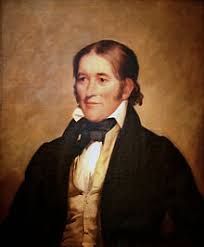
King David I

1805 Monarchical Standard of Kaintuck, featuring the Crockett coat-of-arms
In Tenasee, not quite a micronation but close enough, the government put its troops in the towns and on the border (especially its tiny border with Virginia), and refused to let radicals topple the Revolutionary government. It declared an end to any and all hostilities with its neighbors and tried to focus on stabilizing itself.
Watauga was on the verge of total collapse already by the time of Jackson's coronation. The bloody infighting that had been going on for decades combined with the horrendous military defeats its troops had suffered were bringing it down. By late 1805, Watauga's government had been overthrown by pro-Kaintuck monarchists. Georgia immediately moved in and occupied the country in an indefinite state of martial law.
In Gran Colombia, the once strongly Republican government was so impacted by American influence that it kept right on treating Jackson as its most trusted ally. In the rest of South America, huge pro-monarchy revolts broke out, especially in Brazil, where the banning of impaling only slowed the rise of a new imperial monarchy.
In Tejas, Chihuahua, Yucatan, and Rio Grande, the violence and anarchy of the ongoing war kept everyone's minds off politics and onto survival. The borders of Tejas were so battle-torn and bombed-out that it was said that there were literally entire herds of deer and other desert animals that had been accidentally killed just lying, rotting in the sun. Many of the native tribes were being pushed to extinction and tribal "civil wars" had been becoming increasingly common, with Comanches killing Comanches over disputed resources.
In America, the public rallied and a new wave of volunteers hit the recruiting stations. Tales of knights and other examples of royal splendor became all the rage, leading to an outbreak of propaganda novels such as Alexander Mansum's The Count of Christ Mountain, about a Great Revolution veteran abandoned to the British army during the Battle of Gunpowder Hill (1781) escaping a dank prison in the Falklands, earning an appointment in Jackson's new government, and returning to Christ Mountain, in North Carolina, to get his revenge on his former regiment members. It became an instant classic, and even became popular in Europe. Further promoting a "grand monarchy" spirit, Jackson's architects unveiled blueprints for a massive palace in Philadelphia, at the center of which was a huge fountain. Hence the building was to be named Blue Fountain and was scheduled for completion by 1818. It was hugely delayed by war, however.
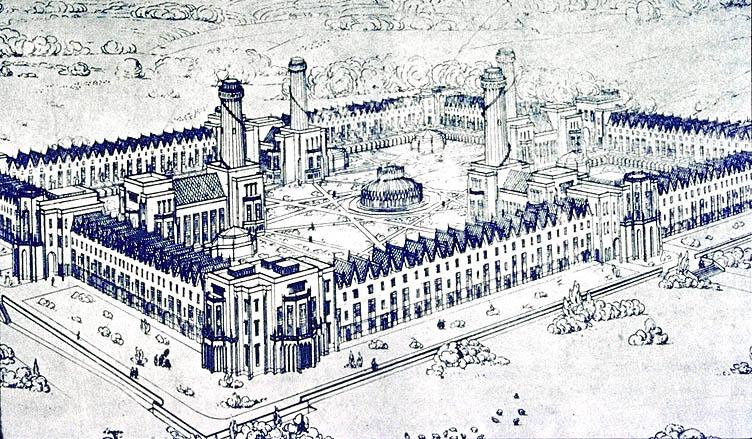
In America's African colonies, the new government proved much more popular with many of the Muslims and Berbers, as they were used to and respected monarchies, such as the Ottoman Empire.
In the rest of Europe, there were mixed feelings about the upstart Andrew. Prussia still felt strongly tied to Britain, and in Britain, parents told their children that if they did not behave or obey, "Old Hickory will come in the bloody window an' haul your bloody rear all the way t' Philadelphia." But Louis the Sixteenth's France became much more positive in its involvement in the war, and Russia announced a new plan to land on the west coast of America and march to Chihuahua and assist in defeating Tejas and Mexico.
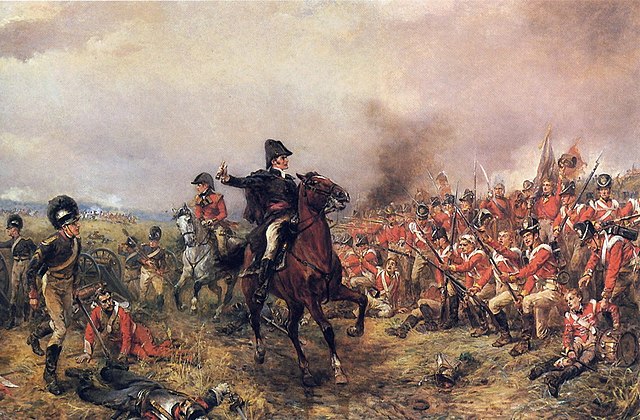
"We are in a position to lose all our holdings in the Western Hemisphere!"
-Arthur Wellesley, Duke of Wellington, in an 1806 letter to British Prime Minister Sydney Smythe (Elected in 1804 from the Cheshire Constituency)
"As I look about our government, I see that there are certain men of certain leanings in the House of Congress that are utterly steadfast in doing what is right. And then there are those who do not follow His Majesty's advice."
- Lord Secretary of Education Noah Webster, 1806
"The Kingdom of the States was made not merely for the generation that now exists, but for posterity- unlimited, undefined, endless, perpetual posterity."
- Minister of the House of Congress Henry Clay, 1805
The start of 1805 had brought a new government into existence, and a new monarch needing to prove just how he deserved the position. To kick off his new reign, Andrew and his generals, and with the help of the Lord Secretary of the Army, Tadeusz Kośiuszko, arranged a plan for the total annihilation of America's enemies. There was one other person involved in the plan, a very unexpected ally: President Bonaparte.
Louisiana had been complaining about getting the short end of the stick for most of the war. Wellington had promised to send troops south for what seemed like a century. Instead, the British army was concentrated on breaking through to New England and Pennsylvania. Thousands of Louisiana's men had died in its attacks in and out of Polypotamia and Illinoisa, on America's side of the Mississippi, and, more recently, in Louisiana itself, where American forces had been breaking through and holding ground. Tejas had requested help from Louisiana, too, which, of, course, Louisiana could not possibly do. To top things off, Joseph Barton, Mexico's dictator, had publicly called Bonaparte a coward. Enough was enough.
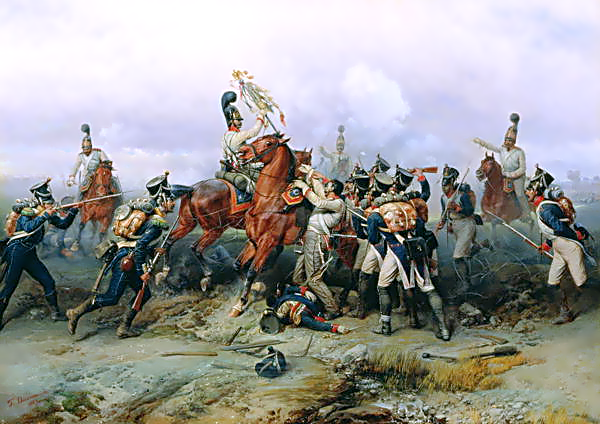
American Bluecoats (44th Pennsylvania Jäger Regiment) overwhelm the white-gray uniformed Louisiana 32nd Chasseurs à Cheval during the bloody American victory at Wabash, Polypotamia

President Bonaparte (dark green uniform, standing on raft, center) greets King Andrew I (dark blue uniform, gray-brown hair, left) and URAS Marine commander and North Africa veteran Hunter DeRensis, Duke of Winterfell, Pennsylvania (removing hat, center); to the far right is David I of Kaintuck (sky blue uniform)
In late 1805, just after a sudden and mysterious troop withdrawal from central and northern Louisiana to the southeast, Bonaparte, Andrew, and David I personally met in the center of the Mississippi River on a raft, near the small Louisianan town of Tylzasippi, and there, they changed the world. After discussing matters for an hour so, the three leaders realized they had much in common, and not just ego size. The trio believed that the Great Revolution might have been unavoidable, but it was too extreme. Moderation was now needed of the hot-headed radicals now in control of the other parts of North and South America. Only Colombia and Britain had any evidence of being moderate, and Britain was allied to the radicals for nothing but revenge and rage. This new era of moderation needed to be brought about by defeating Britain and its allies decisively and quickly. Jackson alone, as great a commander as he was, could not likely do it decisively, and certainly not quickly, with Britain so hellbent on wiping out a nascent new rebel kingdom. Bonaparte became convinced that he would be doing the world, and his country, a favor by switching sides. A deal was struck, and Bonaparte said of Jackson after the meeting that, "Were His Majesty King Andrew a woman, I would marry her. Clearly, I must ask my father when I meet him in Heaven, or Hell, if he had another son named Andre. His Majesty David struck me as... masculine, I suppose. Nothing nearly as brilliant Andrew, who is old enough to be his father." This new friendship brought out that both Bonaparte and Andrew shared a love for Voltaire and a hatred of traditional music. At a meeting a week later in Tylzasippi itself, an American military band went up against a Louisianan one. Both leaders left impressed. David held the opinion that "fiddlin' is fer effeminate dandies. Gimme a rafle and some woods and that's music to my ears," which reportedly received a snicker from Andrew.
A day after, they came to an accord on international affairs, and recognized the new Kingdom of Kaintuck, the Duchy of Wataga (rebel government-in-exile of Georgia-occupied Watauga and led by Napoleon's youngest brother Jerome), and the Free City of Saint Louis (which was to be governed by Napoleon's older brother, Mississippi River trade tycoon Joseph). Saint Louis was one matter of tension between the new-found best friends and King David, but the decision that it would be a free city was granted reluctant approval by the King of the Wild Frontier. Joseph would be Généralissime de Saint-Louis, formally. The bloated ego of Napoleon's oldest brother liked this very much. Jerome was to be General-Duke of Wataga, which was not nearly as wonderful as it sounded, and it was more "General" than "Duke." At this point, Wataga/Watauga was a hellhole and the most unstable place on the continent. Jerome, if his new homeland gained full independence, was to be in command of a militarized buffer state created to solely to further break up areas along the Georgia border. Tenasee was left alone, and America and Georgia started to use the moderated country's Swiss-style banks.
Andrew remarked a year or so later, while looking at a globe in his office, that America was starting to look like a reversed/flipped map of Europe; Britain on both continents' coasts, cold areas to the north, Francophones to the south, Spanish-speakers to the deep south, colonialized savages on the continents below, fractured puppet satellites along the Rhine/Mississippi, and a giant, largely unexplored country, Louisiana, at the end, comparable with underpopulated Russia in Europe. He thought it rather amusing how it had worked out that way, almost as if by design or deliberate analogue.
When the world at large learned of the turncoating, it was shocked. In February of 1806, Louisianan troops swarmed into Watauga/Wataga in full-force under the control of General Harold Bentworth. British-born Georgian General Alexander Richards rode out with a massive cavalry force to attack Bentworth's flank, but actually deliberately led his men into a large trap. The entire cavalry force surrendered without firing a shot, and Richards, a moderate Republican, raised his sword to the Louisiana Eagle Flag and took backwoods militia, riding on the horses the Georgians rode to the surrender, and pummeled a huge gap into the Georgian line. Half of Wataga, and its capital of Nashburg, fell to Louisianan hands.
Andrew used the advance as a distraction to keep his moves secret, and then, like a chess master, launched mad Anthony Wayne into Quebec, thrusting through several Wellington-led counter-attacks, and battling it out near Saint Simon. The disasters unfolding were compounded when French forces land in Newfoundland. Wellington blamed London for his misfortunes, and pleaded for new troops and for the British Navy, under Horatio Nelson, to come and destroy the French fleet at Newfoundland. The French army in Newfoundland was finding itself anything but unwelcome, and the Francophone population was thrilled by the very nonviolent invasion and occupation. Wellington claimed that at this point the French commander, the "accursed" Marquis de Lafayette, could join Wayne in a march on Quebec. Quebec's loyalty was anything but deep, and many hated Wellington for his open hatred of anyone who spoke French. If Quebec fell, so did British America. Wellington said in a letter to his friend and British Prime Minister, the radically revenge-driven Great Revolution veteran Sydney Smythe, that "If Quebec falls, we are in a position to lose all our holdings in the Western Hemisphere!" Smythe, whose two brothers had been impaled at Ticonderoga with Burgoyne, was boiling over with rage, and had to write back the truth: In early June of 1806, the French and American Royal Navies sank the British fleet at Trafalgar in a bloody, climactic, Nelson-killing rout. Nelson had been trying to come through the Pillars of Hercules to attack American North Africa and French Corsica. Admiral Michel Ney had learned of the impending attack and had been more than ready for the battle. Admiral Ney had actually joined the final boarding party and personally shot Nelson in the chest. King George's navy and its leader had been annihilated. Reinforcements would not be coming.
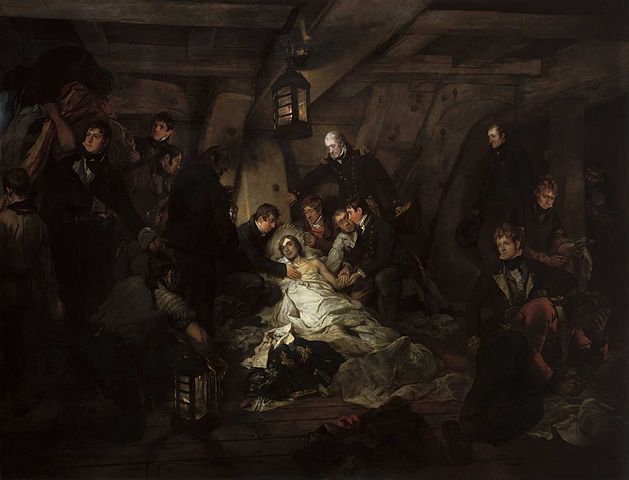
Horatio Nelson dies of wounds surrounded by sympathetic American officers in the hold of the HRMS Benjamin Franklin
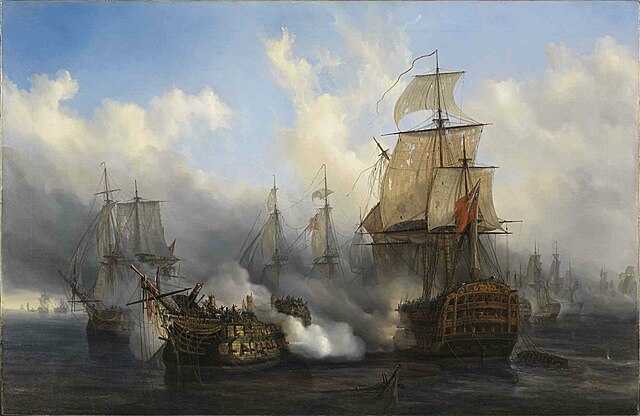
The HMS Victory destroys the HRMS Lucky Lucy shortly before French commander Michel Ney fires the battle-ending gunshot
Paul Revere, the first American to lead troops into battle against British forces, was seized under charges of smuggling slaves to freedom, writing and drawing propaganda against the duly-elected Triumvirs, and advocating genocide, none of which was true, but the last was more then a little ironic. He was impaled in 1788, at the age of 55, "cutting" a promising career short.
An new generation of Americans raised during and after the Great Revolution was about to enter politics and the officer corps. One of this new generation was a young man named Andrew Franklin Jackson. History would never be the same.
Hero of the Republic

Andrew Franklin Jackson at age 23 (1790), upon being appointed cavalry commander of Republican forces at the Siege of Sparta

Andrew Franklin Jackson at age 23 (1790), upon being appointed cavalry commander of Republican forces at the Siege of Sparta
Andrew Jackson, a 23 year-old soldier in 1790, was not a veteran of the Revolution. However, his entire family had died in it, except for his father, also named Andrew, who had died in an accident three weeks before his son was born. Jackson, born in Waxhaws on March 15th, 1767, directly on the border between North and South Carolina, had moved to Virginia upon the Carolinas' secession from the Republic. Fervently believing in the Cause, he enlisted at age seventeen in 1784 and went to the Philadelphia Military Academy. While at PMA, he showed great promise as a commander, leading the other cadets in free-for-all wrestling matches and fisticuffs. He was extremely healthy and fit, and loved the outdoors, but loved to read above all. In his spare time, he usually read books on Caesar, Alexander, Octavian, and Frederick. He sent mail to French officers, requesting they ship him all their newest military books. Before long, he was a seasoned soldier though he had not seen a minute of action, all from reading.
In 1786, at age nineteen, young Jackson published The Supper at Monticello, a pro-Republican pamphlet detailing a fictional meeting of the Triumvirs at Jefferson's palatial estate. Paine loved the writing, and compared it to his own Plain Truth. From that point on, Jackson was Paine's favorite soldier. Immediately, Jackson received a raise in pay and was promoted to captain, unheard of for someone not yet twenty.
In 1786, at age nineteen, young Jackson published The Supper at Monticello, a pro-Republican pamphlet detailing a fictional meeting of the Triumvirs at Jefferson's palatial estate. Paine loved the writing, and compared it to his own Plain Truth. From that point on, Jackson was Paine's favorite soldier. Immediately, Jackson received a raise in pay and was promoted to captain, unheard of for someone not yet twenty.
Over the next year, Jackson became hugely popular with the Philadelphia elite, attending numerous military balls and parties, where he met Dolley Madison, another political exile from North Carolina. Dolley, widow of the late James Madison, who had died in an Indian raid on his plantation, was also widow of John Todd, who died during the Revolution. She was exceedingly beautiful, and everyone who knew her liked her the first minute. Jackson was no exception. For the next few years, he was to be infatuated with her. They became correspondents, and it would continue for a good while.

The next great step in Jackson's life was to be climbed in 1790. On August 2nd of that year, the American Republic declared war on North Carolina. The War of 1790 stemmed from a complex trade conflict which involved the destruction of American property, namely tea and slaves. America launched a massive army under former Richmond Deputy of Public Safety General James Monroe. Monroe pushed three brigades forward down the Appalachians, where he laid siege to Sparta, North Carolina. The North Carolinians put up a fierce defense, bringing up thousands of troops, some of them "neutral" Georgians, fighting in North Carolinian uniforms. Sparta, formerly a backwater, became a battlefield that stretched for miles. The Southrons were determined to hold it to the last man, and General Monroe was determined to squash them into dust. Monroe favored using artillery, and he soon fell into conflict with one of his aides: Andrew Jackson. The observant Jackson had noticed a gap in the defenses the Carolinians had set up, a gap not exploitable by infantry or artillery, but by cavalry. Monroe denied Jackson the men to attack, claiming they would be wiped out. The young captain insisted, but again he was refused. At last, knowing the Republic would lose if he did not act, Jackson scrambled together a cavalry unit, some members nothing more than militia and volunteers lacking even identifiable uniforms. On October 20th, Jackson and his men rode out at break-neck pace toward the gap in the North Carolinian defenses. Swords pointing forward and flintlocks drawn, they crashed through and over the sandbags and feeble brick walls under heavy fire. The brown-coated Southron infantry fired as fast as they could, but Jackson and his men pushed them back, starting a rout. Screaming and shouting, the Southrons panicked and ran like confused ants as steeds galloped down the cobbled streets through a thick, choking screen of smog and smoke.
Across the battlefield, Monroe could not believe what he was seeing. Ever-cautious, he told the other officers to hold their men; there would be no "haphazard" assault on the walls of Sparta.
One person was about to change that. A young woman working as a battlefield nurse and general assistant, Gwendolyn Jones, saw Monroe throwing it all away. Screaming that they were all cowards and that she was willing to become a martyr for the Cause, she picked up a green-white-red banner and demanded others follow her. Inspired, many of the men broke rank and charged after her, screaming, "For Liberty! For the Triumvirate!" as loud as they possibly could. Before long, an entire brigade, 5,000 men, was following Jones across no man's land. Then the artillery disobeyed Monroe and opened up a barrage of canister shot on the walls of Sparta, taking out droves of densely-packed Southrons (most of them that could had gone to high ground to evade Jackson's cavalry) with single canisters. Jones was the first one to reach the walls, and she impaled the first soldier she saw on the flag pole. Huzzahing, the Republicans swarmed in and destroyed the Southrons utterly, brutally exterminating them all. Within an hour, the Siege of Sparta was over, and brown-coated bodies littered the streets, the walls, and the fields.
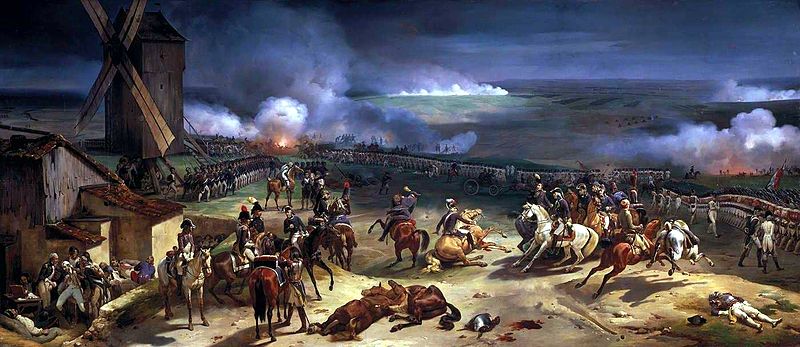
The Siege of Sparta
Monroe stood awe-struck at the performance his soldiers had given. According to tradition, he said while entering the city gate, "By the heavens, I should court-martial Captain Jackson for disobeying his commanding officer and the Republic, but seeing this, I don't care if he did it right after spitting in my face and running off with my daughter. Bloody miracle."
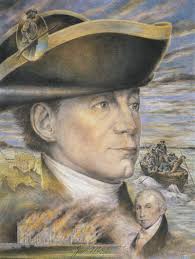
General James Monroe
Jackson met up with Monroe later that night, where Monroe grabbed Jackson's arm and held it triumphantly in the air in front of the army. Gwendolyn Jones was hoisted on the shoulders of two troopers and carried around like a hero, with many proclaiming her the "Lady of the Republic." The name stuck.
Faced with the roaring, inspirational performance of the young captain, Second Triumvir Aaron Burr had him appointed to colonel and Cavalry Commander of the Army of Appalachia. Jackson was now James Monroe's right-hand man and friend. The Carolinian Colonel was now truly on the road to great power.
The next move in the war, in Jackson's opinion, was for him to take a brigade and his loyal cavalry and march south-west along the Blue Ridge Mountains to cut off the flow of equipment and "secret reinforcements" from Bulloch's Georgia. Monroe agreed, and marched his forces south-east toward Chapel Hill, where the Virginian general utterly annihilated a pitiful force under Major John Winslow Hubert. Jackson accomplished his goal and started taking one Georgian prisoner after another, along with wagon trains of supplies. The Georgian POW's were forced-marched north into Virginia, where they were held at huge prisons. Jackson saw to it that a few hundred troops were stationed in strategic areas to keep the peace, and then marched east to Charlotte, where he took the city after a two-week siege. Finally, he met up once again with General Monroe and together they took the capital of Raleigh. Country destitute and depopulated, the North Carolinian army fled to the Coastal Plains after America repeatedly rejected peace offers. At last, in late January, 1791, the army of North Carolina was completely wiped out in huge swaths all along the Outer Banks. Victory belonged to the Republic; there would be no peace treaty, because there was no North Carolina to sign it. It was completely and totally subjugated.
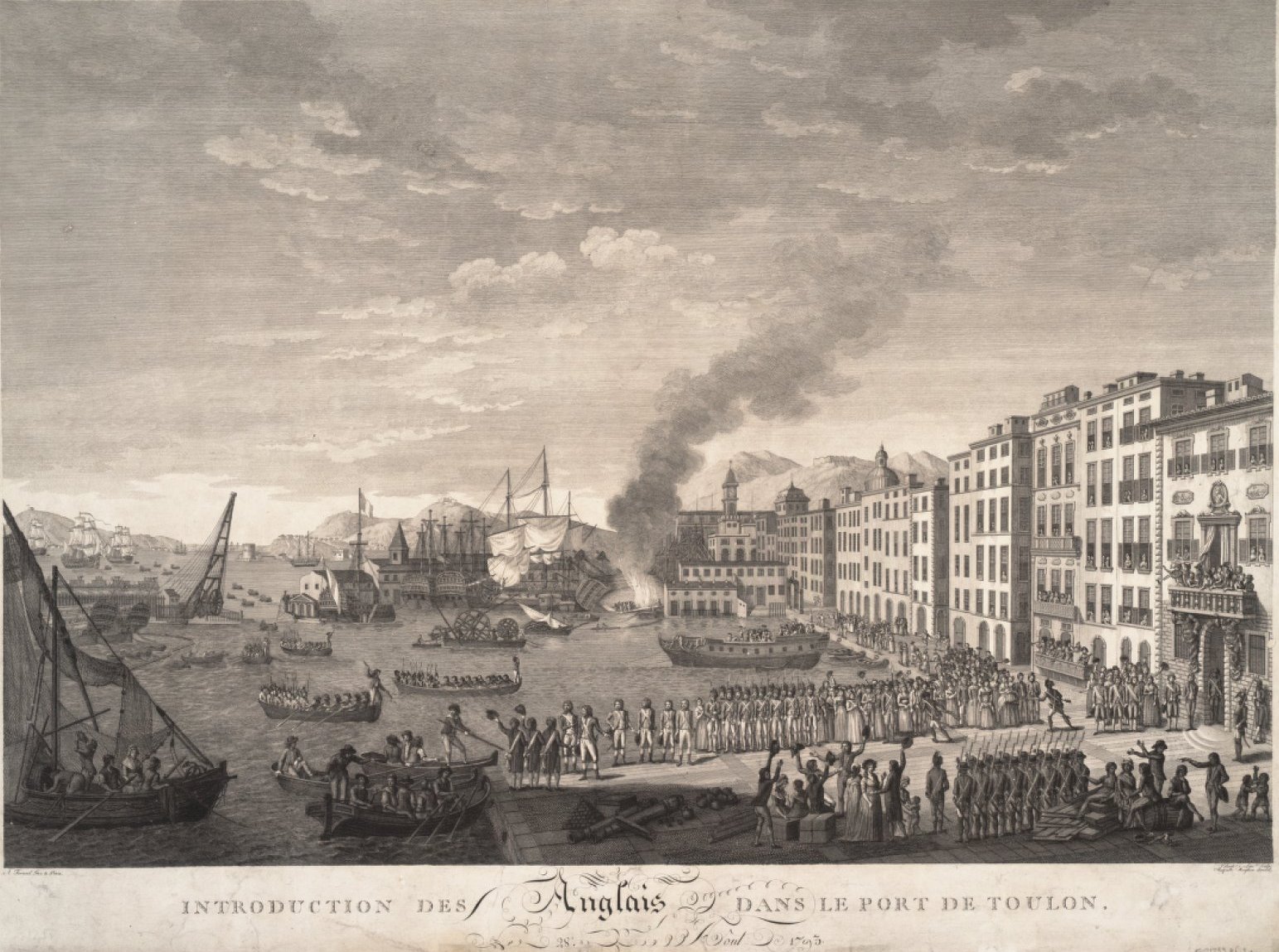
American troops land at Cape Fear, North Carolina, in this 1792 etching
When Jackson returned to the North, he was welcomed as a huge hero, and was promoted to Brigadier-General at the age of 24.
Jackson then set about drawing up a plan to present to the Triumvirs. He pointed out that Panama was likely the only passage to the Pacific without going around South America. If a canal could be built, he claimed, new trade routes could be started and a clear path could be made to British India, in case of the expected future rematch with King George, would allow decisive action to be taken, along with opening up anarchist southern Mexico to colonization. Jose Fernandez, Hamilton's old aide and disciple and current Presidente of Gran Colombia, had been trying to bring the savages and stubborn citizens of Panama to heel for over five years. If the American army moved quickly and decisively, the Isthmus would be theirs.
Nicholas was a young man from Georgia who had left his motherland to spread the Revolution elsewhere, namely, in New Spain. For years, he harassed and attacked Spanish and loyalist towns and wagons, collecting a small fortune in the process. Also, during this time, he became the first famous American outlaw, a new breed of rugged pioneer out typically for themselves, but who, occasionally, like Nicholas, stole and killed for something greater than themselves. After New Spain pulled out of Louisiana, Young went back to living a fairly peaceful life. It lasted only a few years before he was called out of civilian life by the government of Tejas. Young knew every bit of the land, something none of the Tejas military officers could say. So, in late 1789, he was appointed Head of the Army. Marshal Young was born. He immediately took the fight to Rio Grande, crossing the river with a force 8,000 men strong. In January of 1790, Rio Grande agreed to a ceasefire. However, tensions were far from over.
Another thing far from over was the career of Nicholas Young. In the 1792 elections, he was elected President of Tejas by a good majority. The Triumvirate had another competent rival to watch out for. Before Young, power in Tejas had belonged to a long list of governors, dictators, and presidents, all of whom were voted out within short times. Young was the first popular Tejas leader. It was the beginning of a new era in the North American West.


Even though many Indians had been killed or exiled, there were still plenty left. Indian raids would be threats in the Louisiana region until the 1840s.
There was no unifying figure in Louisiana aside from President Walton during this period, but the son of immigrants would change that. Napoleone di Buonaparte, born in 1769 in Ajaccio, Corsica, to Carlo Buonaparte and Letizia Ramolino, was just a young boy during the Great Revolution, but it had a huge effect on him. His merchant father (who had moved his clan to America to escape the bloodshed of the French Subjugation of Corsica) had been killed by the pirates in 1785 while making a business trip to South America. Napoleone and his brothers and sisters, Joseph, Lucien, Elisa, Louis, Pauline, Caroline, and Jerome helped support their widowed mother until she died of grief in 1788. Napoleone's older brother Joseph moved the family west to make their fortune along the Mississippi. Joseph eventually became a successful river tycoon and built the huge "Casa Buonaparte" in New Orleans City along the bayou.
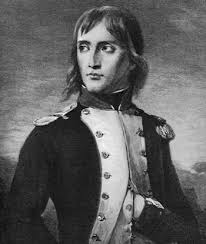
Buonaparte (circa Bloody Creek)
Young Napoleone, age 14, applied for enrollment at the La Nationale de la Louisiane Académie Militaire in 1783, where he became a radical republican and saw that the Triumvirate was a growing dictatorship. He graduated with flying colors and at the age of 19 was appointed corporal in the 3rd New Orleans Regiment of Foot (1787). He gained much experience in the Cherokee-Georgia War of 1787-89, and fought alongside the 34th Georgia Infantry, the famed Dahlonega Dragons, at Bloody Creek on March 13th, 1787, where the Cherokee leadership was utterly destroyed, leaving the last two years of the "war" to petty crimes and cabin burning.
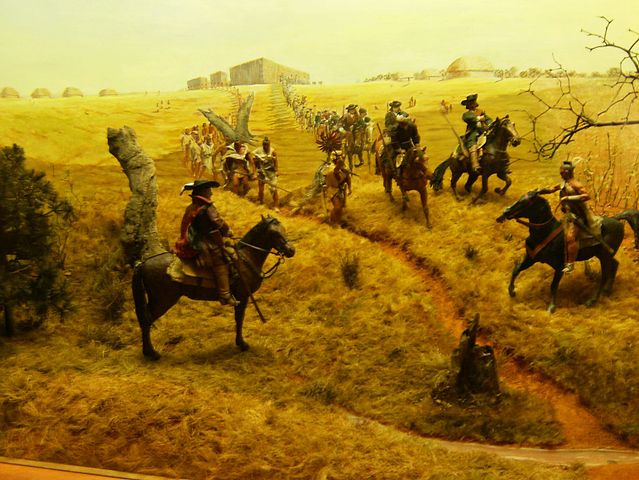
Creek warriors and Catholic soldiers march out to go on the offensive during the Floridian Civil War
In 1791, Spain sold its last North American colony, Florida, to Georgia for 3,000,000 Georgian Pounds after Georgia, South Carolina, and Louisiana threatened to drive the aging empire out by force. Florida was certainly not welcome to the idea of being absorbed by its bloated northern neighbor. Its people were either Indian or Spanish for the most part, and Georgia was neither of those things. Thus, when Georgian and South Carolinian troops (provided by S. Carolina president Francis Marion) crossed the border to begin the "purification" of their new region, the Floridian Civil War began. In the panhandle, the majority of people were white Protestants. In all the rest, it was Catholics and Natives. In 1792, the former colonists and Indians signed an alliance to drive out their new landlords and northern neighbors. The leading figure was the Maryland-born former British Loyalist William Augustus Bowles, who had turned himself into a guerrilla fighter.
Napoleone di Buonaparte volunteered for the Louisiana Expeditionary Corps during the Civil War and was shipped to Pensacola in early 1793. From 1793 to 1795, the height of the bloody conflict, he acquired a reputation as one of the best Indian-fighters in the world, earning the rank of captain easily. Finally, exhausted and tired, Georgia agreed to the Treaty of London, which allowed all territory south of Palatka independence, with Bowles as Dictator-President. So, on April 2nd, 1796, the Republic of Muskogee was born.

Flag of Independent Muskogee
The Florida Civil War spurred on nationalist movements elsewhere. In Mexico, Hamilton and David's doctrines still had roots, and a nationalist revolution against the Spanish puppet government swept the north. What emerged was the Glorious Republic of Chihuahua, a close ally of Rio Grande. In the south, Chiapas and Oaxaca declared independence, which was not welcomed by its immediate neighbor to the east, Yucatan, which, supported by an American army under Andrew Jackson himself, invaded and subjugated the small states in 1798. Durango formed a confederation with Zacatecas and Nayarit in 1797, and became the Confederate States of Mexico. Jalisco and Colima soon joined the Confederacy. White plants and provocateurs were immediately sent to the Confederate States to engineer its political slant; the Southron Alliance won out, in no small thanks to the Catholic half-Hispanic half-American Joseph Barton, a traitor to America who worked for the Georgia government. Due to assassination and political maneuvering, he became Dictador de la Confederación. It was only the beginning for this political extremist.
Following the victories in North America, Jackson finally asked for the hand of Dolly Madison, who accepted wholeheartedly. On New Year's Day, 1795, they were married in Freedom Square. It was a national celebration.
Now with almost uncontrollable power, he asked the Triumvirate once again for permission to invade Panama. They agreed, frightened what might happen if they gave any other answer.
So, in 1797, he departed amid much fanfare on the Republic's finest ships. When they landed in May, the army of Gran Colombia marched to join him, waving Revolutionary tricolors and singing his praises. Jacques Louis David was one of Jackson's staff members, and this only made the Colombians love him more. In June, they attacked, quickly destroying all resistance in Panama with American muscle. Gran Colombian soldiers were sent in to assist Jackson in building his precious canal.
During the initial stages of construction in 1797, all was seemingly going well, and Jackson departed to march north into southern Mexico, where Yucatan was requesting assistance in invading the tiny new nation-states of Chiapas and Oaxaca. In early 1798, he was stretching his forces across huge amounts of wasteland, which was not sustainable. He essentially took the wheel of the Yucatan army and combined it with his own. Then, he forced the main rebel army into a newly-discovered ancient temple complex known as Loalaxca, near the Gulf of Tehuantepec. In the epic Battle of the Pyramids, Andrew Jackson annihilated 5,000 enemy soldiers, including some Georgians, at the loss of only 70 men. His unbelievably effective use of artillery, infantry, and cavalry in the tight confines of the temple complex is considered to this day one of the finest military victories of all time. Within a week, Yucatan was in control.
Back in Panama, however, things were not going so well. Yellow fever was ravaging the engineers and the Colombian workers. They were down to half strength. Jackson quickly proclaimed the canal could not be completed with the disease killing so many men. He left garrisons in key locations and proclaimed it a Colony of the Republic. In early 1799 he headed back to America, where he was about to make the biggest gamble of his life...

Dolley Madison
The next great step in Jackson's life was to be climbed in 1790. On August 2nd of that year, the American Republic declared war on North Carolina. The War of 1790 stemmed from a complex trade conflict which involved the destruction of American property, namely tea and slaves. America launched a massive army under former Richmond Deputy of Public Safety General James Monroe. Monroe pushed three brigades forward down the Appalachians, where he laid siege to Sparta, North Carolina. The North Carolinians put up a fierce defense, bringing up thousands of troops, some of them "neutral" Georgians, fighting in North Carolinian uniforms. Sparta, formerly a backwater, became a battlefield that stretched for miles. The Southrons were determined to hold it to the last man, and General Monroe was determined to squash them into dust. Monroe favored using artillery, and he soon fell into conflict with one of his aides: Andrew Jackson. The observant Jackson had noticed a gap in the defenses the Carolinians had set up, a gap not exploitable by infantry or artillery, but by cavalry. Monroe denied Jackson the men to attack, claiming they would be wiped out. The young captain insisted, but again he was refused. At last, knowing the Republic would lose if he did not act, Jackson scrambled together a cavalry unit, some members nothing more than militia and volunteers lacking even identifiable uniforms. On October 20th, Jackson and his men rode out at break-neck pace toward the gap in the North Carolinian defenses. Swords pointing forward and flintlocks drawn, they crashed through and over the sandbags and feeble brick walls under heavy fire. The brown-coated Southron infantry fired as fast as they could, but Jackson and his men pushed them back, starting a rout. Screaming and shouting, the Southrons panicked and ran like confused ants as steeds galloped down the cobbled streets through a thick, choking screen of smog and smoke.
Across the battlefield, Monroe could not believe what he was seeing. Ever-cautious, he told the other officers to hold their men; there would be no "haphazard" assault on the walls of Sparta.
One person was about to change that. A young woman working as a battlefield nurse and general assistant, Gwendolyn Jones, saw Monroe throwing it all away. Screaming that they were all cowards and that she was willing to become a martyr for the Cause, she picked up a green-white-red banner and demanded others follow her. Inspired, many of the men broke rank and charged after her, screaming, "For Liberty! For the Triumvirate!" as loud as they possibly could. Before long, an entire brigade, 5,000 men, was following Jones across no man's land. Then the artillery disobeyed Monroe and opened up a barrage of canister shot on the walls of Sparta, taking out droves of densely-packed Southrons (most of them that could had gone to high ground to evade Jackson's cavalry) with single canisters. Jones was the first one to reach the walls, and she impaled the first soldier she saw on the flag pole. Huzzahing, the Republicans swarmed in and destroyed the Southrons utterly, brutally exterminating them all. Within an hour, the Siege of Sparta was over, and brown-coated bodies littered the streets, the walls, and the fields.

The Siege of Sparta
General James Monroe
Jackson met up with Monroe later that night, where Monroe grabbed Jackson's arm and held it triumphantly in the air in front of the army. Gwendolyn Jones was hoisted on the shoulders of two troopers and carried around like a hero, with many proclaiming her the "Lady of the Republic." The name stuck.
Faced with the roaring, inspirational performance of the young captain, Second Triumvir Aaron Burr had him appointed to colonel and Cavalry Commander of the Army of Appalachia. Jackson was now James Monroe's right-hand man and friend. The Carolinian Colonel was now truly on the road to great power.
The next move in the war, in Jackson's opinion, was for him to take a brigade and his loyal cavalry and march south-west along the Blue Ridge Mountains to cut off the flow of equipment and "secret reinforcements" from Bulloch's Georgia. Monroe agreed, and marched his forces south-east toward Chapel Hill, where the Virginian general utterly annihilated a pitiful force under Major John Winslow Hubert. Jackson accomplished his goal and started taking one Georgian prisoner after another, along with wagon trains of supplies. The Georgian POW's were forced-marched north into Virginia, where they were held at huge prisons. Jackson saw to it that a few hundred troops were stationed in strategic areas to keep the peace, and then marched east to Charlotte, where he took the city after a two-week siege. Finally, he met up once again with General Monroe and together they took the capital of Raleigh. Country destitute and depopulated, the North Carolinian army fled to the Coastal Plains after America repeatedly rejected peace offers. At last, in late January, 1791, the army of North Carolina was completely wiped out in huge swaths all along the Outer Banks. Victory belonged to the Republic; there would be no peace treaty, because there was no North Carolina to sign it. It was completely and totally subjugated.

American troops land at Cape Fear, North Carolina, in this 1792 etching
When Jackson returned to the North, he was welcomed as a huge hero, and was promoted to Brigadier-General at the age of 24.
Jackson then set about drawing up a plan to present to the Triumvirs. He pointed out that Panama was likely the only passage to the Pacific without going around South America. If a canal could be built, he claimed, new trade routes could be started and a clear path could be made to British India, in case of the expected future rematch with King George, would allow decisive action to be taken, along with opening up anarchist southern Mexico to colonization. Jose Fernandez, Hamilton's old aide and disciple and current Presidente of Gran Colombia, had been trying to bring the savages and stubborn citizens of Panama to heel for over five years. If the American army moved quickly and decisively, the Isthmus would be theirs.
Meanwhile...
Beyond the American Republic
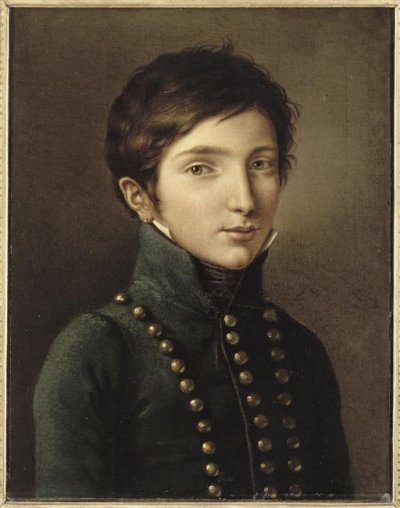
Portrait of young Napoleone di Buonaparte in Louisiana uniform
As young Jackson became the hero of a nation in the east, the other nations were still quite active producing heroes of their own. For several years, Tejas and Rio Grande had been in an undeclared war, each side trying to grab hold of different important regions. Nothing seemed to be an ultimate objective, and it derailed into violence for violence's sake. A new figure was about to become a Tejas legend: Nicholas Young. Beyond the American Republic

Portrait of young Napoleone di Buonaparte in Louisiana uniform
Nicholas was a young man from Georgia who had left his motherland to spread the Revolution elsewhere, namely, in New Spain. For years, he harassed and attacked Spanish and loyalist towns and wagons, collecting a small fortune in the process. Also, during this time, he became the first famous American outlaw, a new breed of rugged pioneer out typically for themselves, but who, occasionally, like Nicholas, stole and killed for something greater than themselves. After New Spain pulled out of Louisiana, Young went back to living a fairly peaceful life. It lasted only a few years before he was called out of civilian life by the government of Tejas. Young knew every bit of the land, something none of the Tejas military officers could say. So, in late 1789, he was appointed Head of the Army. Marshal Young was born. He immediately took the fight to Rio Grande, crossing the river with a force 8,000 men strong. In January of 1790, Rio Grande agreed to a ceasefire. However, tensions were far from over.
Another thing far from over was the career of Nicholas Young. In the 1792 elections, he was elected President of Tejas by a good majority. The Triumvirate had another competent rival to watch out for. Before Young, power in Tejas had belonged to a long list of governors, dictators, and presidents, all of whom were voted out within short times. Young was the first popular Tejas leader. It was the beginning of a new era in the North American West.
President Nicholas Young
In Louisiana, there were no wars or quasi-conflicts with neighboring countries. Instead, the Indian Wars had just begun. There were more Native Americans than whites in many areas. The northern regions of Louisiana (North Missouri, Montainia, Minnesquotah, Daquotah) were completely different from the south (South Missouri, Akansea, Cimarron, Oklowma, New Orleans). In the west, Colorado was like none of the others. The main reason they stuck together was the constant threat from the natives. Thousands of them roamed the plains and mountains at will, burning and killing the oncoming whites every day. Clearly, something had to be done. When President George Walton of Louisiana signed the Pact of Gulfport in 1786 with President Bulloch of Georgia, a plan to solve the "Indian Question" was created: mass forced deportation and Louisianan and Georgian troops fighting side-by-side to do it. Beginning around 1788, the mass removal of the Natives began. Thousands were rounded up and forced either up north into Canada, much to the opposition of the British, or past the Rockies into Navajo and Apache territory. Western expansion exploded. Several of America's remaining Revolutionaries, including Johnny Adams and John Jay, headed out to stake their claims and live out the rest of their lives in peace, or so they hoped; Adams was killed in a terrible cliff-related hunting accident in 1802, leading to many accusations against America.

Coloradan soldiers "escort" Indians from the Mississippi River and Daquotah areas into the hostile, unexplored Nevaja Territory
Even though many Indians had been killed or exiled, there were still plenty left. Indian raids would be threats in the Louisiana region until the 1840s.
There was no unifying figure in Louisiana aside from President Walton during this period, but the son of immigrants would change that. Napoleone di Buonaparte, born in 1769 in Ajaccio, Corsica, to Carlo Buonaparte and Letizia Ramolino, was just a young boy during the Great Revolution, but it had a huge effect on him. His merchant father (who had moved his clan to America to escape the bloodshed of the French Subjugation of Corsica) had been killed by the pirates in 1785 while making a business trip to South America. Napoleone and his brothers and sisters, Joseph, Lucien, Elisa, Louis, Pauline, Caroline, and Jerome helped support their widowed mother until she died of grief in 1788. Napoleone's older brother Joseph moved the family west to make their fortune along the Mississippi. Joseph eventually became a successful river tycoon and built the huge "Casa Buonaparte" in New Orleans City along the bayou.
Buonaparte (circa Bloody Creek)
Young Napoleone, age 14, applied for enrollment at the La Nationale de la Louisiane Académie Militaire in 1783, where he became a radical republican and saw that the Triumvirate was a growing dictatorship. He graduated with flying colors and at the age of 19 was appointed corporal in the 3rd New Orleans Regiment of Foot (1787). He gained much experience in the Cherokee-Georgia War of 1787-89, and fought alongside the 34th Georgia Infantry, the famed Dahlonega Dragons, at Bloody Creek on March 13th, 1787, where the Cherokee leadership was utterly destroyed, leaving the last two years of the "war" to petty crimes and cabin burning.
Creek warriors and Catholic soldiers march out to go on the offensive during the Floridian Civil War
In 1791, Spain sold its last North American colony, Florida, to Georgia for 3,000,000 Georgian Pounds after Georgia, South Carolina, and Louisiana threatened to drive the aging empire out by force. Florida was certainly not welcome to the idea of being absorbed by its bloated northern neighbor. Its people were either Indian or Spanish for the most part, and Georgia was neither of those things. Thus, when Georgian and South Carolinian troops (provided by S. Carolina president Francis Marion) crossed the border to begin the "purification" of their new region, the Floridian Civil War began. In the panhandle, the majority of people were white Protestants. In all the rest, it was Catholics and Natives. In 1792, the former colonists and Indians signed an alliance to drive out their new landlords and northern neighbors. The leading figure was the Maryland-born former British Loyalist William Augustus Bowles, who had turned himself into a guerrilla fighter.
Napoleone di Buonaparte volunteered for the Louisiana Expeditionary Corps during the Civil War and was shipped to Pensacola in early 1793. From 1793 to 1795, the height of the bloody conflict, he acquired a reputation as one of the best Indian-fighters in the world, earning the rank of captain easily. Finally, exhausted and tired, Georgia agreed to the Treaty of London, which allowed all territory south of Palatka independence, with Bowles as Dictator-President. So, on April 2nd, 1796, the Republic of Muskogee was born.
Flag of Independent Muskogee
Jackson Takes the Wheel
The Subjugation of Panama
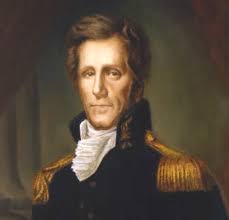
General Jackson
The Subjugation of Panama
General Jackson
The unbelievable performance given by Jackson in North Carolina was only compounded by his awe-inspiring restructuring of the Midwest Territory. And also covered up the impaling of New York separatist and original Founding Father George Clinton. First Jackson set up the tiny Lone Star Republic of Tenasee, and then took advantage of his growing personality cult to befriend the Kaintucky government, which had seceded over the Triumvirate issue, and slowly was drifting the substantial country back into orbit as an American satellite. While visiting, he helped crush the remaining Indians in the Kaintucky-Tenasee-Watauga area, which made all three nations adore him. He was especially helped by Generals Tadeusz Kościuszko and Anthony Wayne, both veterans of the Great Revolution.
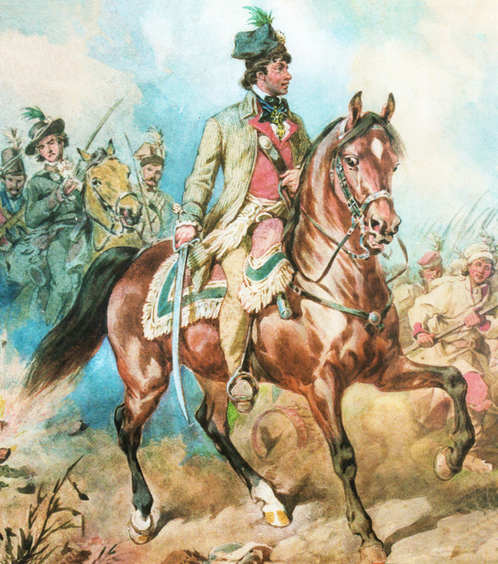
Tadeusz Kośiuszko
Tadeusz Kośiuszko
Jackson's close friend, Gwendolyn Jones, was also busy organizing a radical "Jacksonian Party," was becoming the first famous American woman and practically the American Joan of Arc. She was hugely popular, and there were no laws or rules about women serving in the government (because it was considered so ludicrous), and she took advantage of that fact. On the side from organizing the Jacksonian Party, she continued being a battlefield "assistant;" for all basic purposes, a general, and advised and accompanied Jackson on his trip to the Midwest.
Following the victories in North America, Jackson finally asked for the hand of Dolly Madison, who accepted wholeheartedly. On New Year's Day, 1795, they were married in Freedom Square. It was a national celebration.
Now with almost uncontrollable power, he asked the Triumvirate once again for permission to invade Panama. They agreed, frightened what might happen if they gave any other answer.
So, in 1797, he departed amid much fanfare on the Republic's finest ships. When they landed in May, the army of Gran Colombia marched to join him, waving Revolutionary tricolors and singing his praises. Jacques Louis David was one of Jackson's staff members, and this only made the Colombians love him more. In June, they attacked, quickly destroying all resistance in Panama with American muscle. Gran Colombian soldiers were sent in to assist Jackson in building his precious canal.
During the initial stages of construction in 1797, all was seemingly going well, and Jackson departed to march north into southern Mexico, where Yucatan was requesting assistance in invading the tiny new nation-states of Chiapas and Oaxaca. In early 1798, he was stretching his forces across huge amounts of wasteland, which was not sustainable. He essentially took the wheel of the Yucatan army and combined it with his own. Then, he forced the main rebel army into a newly-discovered ancient temple complex known as Loalaxca, near the Gulf of Tehuantepec. In the epic Battle of the Pyramids, Andrew Jackson annihilated 5,000 enemy soldiers, including some Georgians, at the loss of only 70 men. His unbelievably effective use of artillery, infantry, and cavalry in the tight confines of the temple complex is considered to this day one of the finest military victories of all time. Within a week, Yucatan was in control.
Back in Panama, however, things were not going so well. Yellow fever was ravaging the engineers and the Colombian workers. They were down to half strength. Jackson quickly proclaimed the canal could not be completed with the disease killing so many men. He left garrisons in key locations and proclaimed it a Colony of the Republic. In early 1799 he headed back to America, where he was about to make the biggest gamble of his life...
Remember, Remember, the 4th of November
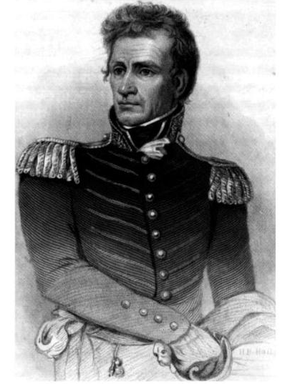
Andrew Jackson circa 1799

Andrew Jackson circa 1799
In early 1799, Andrew Jackson returned from his Latin American adventure. He hardly recognized Philadelphia. Corruption was everywhere, including in the Triumvirate. Even worse, the 62 year-old Paine was bedridden after developing pneumonia, and his death was expected. Burr, as Second Triumvir, was to replace him. Jackson cringed at the thought; Burr had done nothing but support Paine. In short, he was spineless. And so, on October 1st, 1799, Jackson was called to visit the ailing First Triumvir. A scheme of a lifetime was about to be hatched.
Jackson removed his bicorne and greatcoat when he entered the Mansion of the First Triumvir and a slave took them and hung them on a rack. The young officer, only 32 and a full-fledged general, walked up a set a mahogany stairs and was greeted at the top by several periwiged white servants, both with solemn expressions on their normally stoic faces. They opened a large door and ushered Jackson into the room. In the far corner of the ornately decorated room, which was complete with exquisite paintings and portraits by Italian masters, laid Paine, looking extremely sickly on his bed, covered with sheets and and coughing severely. The general approached respectfully and raised his fist, saluting, "Long live the Republic!"
"Glory be!" Paine returned weakly. He raised his sweaty, boney palm and then let it plop down.
"You wanted to see me, Your Excellency? I am honored," Jackson said, giving a slight bow.
Paine grinned ever so slightly. "Yes, General Jackson, I did. I'm not going to make it. I wish I could serve the Republic till I was as old as Methuselah, but I fear I won't. Oh, well. Methuselah did not exist, anyway," the devout atheist chuckled. "I wanted to talk to you about Burr. In short, he is pathetic. He has always just done what I have done, but he won't be able to do that anymore. He'll have to make his own way, Jefferson will become Second Triumvir, and heaven... er, goodness knows who'll be voted in for Third Triumvir. I strongly think that Jefferson will have far too much sway over Burr. Even if you ran and won as Third Triumvir, and I assure you you would win, they would have a majority and would control you. It would be the end of expansion and army-building, right as we are beginning to dominate two continents. The time has come for change. I have consulted with many of our generals, including your friend General Monroe, and we have decided the time is right for a coup. I want to offer you the position of supreme leader. After that, it would be up to you to decide what direction to take the government. What say you, General?"
Jackson was stunned. He had just been offered the office of dictator of the entire country. "Surely there are better-qualified men than I."
"In short," Paine said quickly, "No."
Jackson pulled up a chair next to Paine's bed and sat down to think. After ten minutes, he answered. "If I failed in an attempt to take control, I would undoubtedly be charged with high treason and likely impaled. What say you, Your Excellency?"
"The army is behind you 100 percent. They practically worship you. General Monroe says he can, without suspicion, bring in enough troops to overwhelm any government loyalists and install you as leader. Hamilton says he can sway a large number of current politicians to join you. Now, Jackson, my time is short--literally. What is your answer?"
"Yes."
And with that, fates were sealed.
On October 28th, 1799, Thomas Paine died and was laid to rest in Freedom Square. A week of nation-wide morning followed, and portraits of him hung everywhere, even in other countries. Paine had been a main source of inspiration for the other revolutions; in South America, where the last European powers had been pushed out, special editions of Plain Truth were produced with a high-quality picture of Paine on the first page. A massive parade was held in Caracas, Gran Colombia, in his honor, which Jacques-Louis David attended. Some European nations sent condolences, namely Venice, Milan, Russia, and France. Other nations rejoiced in his demise, such as Britain and Prussia.
After the week passed, it was time to strike. On November 4th, Jackson met Hamilton at Hamilton's estate in the Philadelphia countryside. General Anthony Wayne was also present in the plotting, telling Jackson that he could easily get his friend Ethan Allen, dictator of the Green Mountain Republic, to support a new government. Following this meeting, Jackson, Hamilton, and Wayne rode in a carriage to Philadelphia. After rounding up fellow conspirators and an appropriate number of Monroe-supplied troops, Jackson put the plan into action. At noon, 800 infantrymen suddenly left their stations around the city and marched to the capitol. Ten cannons were arranged around all the exits, and the cavalry circled around the surrounding property, making sure they were a second ring to nab anyone who tried to escape. Finally, Jackson mounted his horse and galloped up the stairs of America's seat of government, backed-up by a squad of dragoons on foot; the strongest, beefiest soldiers in Philadelphia. He rode the horse up a flight of marble stairs and pointed his drawn sword at the locked oaken doors of Administrative Hall, where the Triumvirs and their advisers sat and carried on their business. The muscle-bound dragoons used their carbines and jackbooted feet to kick in the doors, which fell off their hinges with a bang. In a flash, the troops were upon the officials. Jefferson and Burr fled down a secret escape tunnel behind a painting of Benjamin Franklin, but the troops were far too fast for them, and they were promptly seized. The Triumvirate Guards, the government's most radical soldiers, rushed in to stop the coup, and shots flew back and forth. In the crossfire, old patriot Patrick Henry was struck in the shoulder. He staggered and fell out a window and died on the cobbled ground below. Jackson put himself in the middle of the fighting, and used his sword to run several Guards through. Thomas Mifflin, an old key player in Revolutionary politics and one of the Triumvirate's advisers, joined the Guards, and was killed by a sabre strike to the jugular vein. He fell dead, blood spurting out his mouth. In the ensuing hour, the Guards were slowly pushed back and out. Once pushed out the front doors of the capitol, the firing squads outside opened fire. Screaming in horror, the Guards fled in every direction. That was when the cannons opened up. In twenty seconds, 200 Guards were killed.

Jackson addresses the army
Jackson wiped the blood off his sword with his red sash and sheathed it in its scabbard. He straightened his hat, adjusted his coat-tails, and stepped outside. With a grim-looking smile, he shouted to the troops, "Long Live the Republic!"
"Glory be to Jackson!" they replied, breaking ranks and rushing him jubilantly. They threw their hats in the air, fired off their guns, and carried Jackson on their shoulders in celebration. They carried him in a huge march through the city. People soon picked up on what had happened and cheered alongside the troops. Crowds of children sang Revolutionary songs, old men watched with pride, and loyalists fled.
General Monroe led a substantial force to round up those who were at that moment surely preparing to flee to the west and north. Over the next week, 500 members of the old regime were hunted down and imprisoned. The rest of the government swore oaths of loyalty to Jackson's dictatorship.
The Jacksonian Era had begun.
War with the Turks
Jackson's First International Conflict as Leader
Jackson's First International Conflict as Leader

Bloody Fighting at the Tripoli Embassy Siege
When Jackson seized power on the 4th of November Coup, the new government made little difference to the Mohammedan corsairs, based out of Ottoman Turkey's protectorates in North Africa, who had been ravaging American (and international) shipping in the Mediterranean and Atlantic. Seeing the Republic as weak, distant, and unable to respond, the Berbers went after anything flying American colors, sinking a total of 30 good-sized trade and patrol vessels between December, 1799, and January, 1800. This ruthless pillaging and piracy made a chorus of war cries sally forth from Chancellor Jackson's advisers, including the new Foreign Minister Alexander Hamilton and new Grand Marshal Anthony Wayne.
Wayne stressed that the corsairs not be allowed to further their murder and that an invasion should commence immediately. Hamilton, on the other hand, said that a naval blockade and small-scale bombardment, aiming only for structures and not people, would be the wiser move, and might possibly cause the Sultan to think twice about declaring an actual war. Needless to say, Jackson went with Wayne's roughnecked assault plan. Jackson and Wayne were two of a kind, and Hamilton sighed and tried to draft a new plan in early January.
Consulting with Russian and Austrian ambassadors, a plan for a three-pronged attack was planned against the Ottoman Empire. Field Marshal Mikhail Kutuzov was to take the Russian army and assault the Ottoman protectorate in the Crimea. The Austrian army, under Karl Philipp, Prince of Schwarzenburg, was to lead the Holy Roman Empire in a new crusade to demolish the Sultan's forces in the Balkans and lay siege to Constantinople, or, as the Mohammedans preferred, Istanbul. The American army and navy, meanwhile, was to utterly shellack all the corsairs and Imperial ships near Gibraltar and then sail on to Tripoli, where a large army of marines, under the young Commander Hunter DeRensis, was to storm the pasha's palace and take alive or dead the Berber leadership. Hopefully, the Turks would be confused and surrounded by its enemies and forced to accept a miserable peace. With Austrians and revolutionary Greeks and Bulgars assaulting Constantinople, the Sultan could not dispatch ships to aid the Berbers against the Americans if he had any common sense at all. With the Russians in control of the Crimea, the very real threat of invasion from the rear of Constantinople, over mainland Anatolia, was something that made every Turk tremble in his turban. With the Americans making mincemeat out of the Berbers, as they were expected to be able to do with a little help from the local Italian countries that had been taking Berber abuse for centuries, the Berbers would not only be prevented from sailing to relieve the defenders of Istanbul, but would be completely destroyed and their looting, raping, and killing halted for all time.
While this was hatched and begun to be put into motion, the citizens of Tripoli, not having a clue as to what was to befall them, began rioting at the American Embassy of Tripoli, where the garrison and ambassadors, under Major Gunther Miles, also had no knowledge of the coming invasion. Shortly after an assassin was killed during an attempt on Miles' life on April 22nd, shots were fired, and the garrison raked the angry crowds with musket fire. Trapped and surrounded by angry rioters, militias, pirates, and unsavory Turkish mercenaries, the Americans built the embassy into a fort, and assault after assault was beaten back. After two weeks of fighting, the invading marine force under Commander DeRensis stormed the shores of Tripoli, battering through poorly-trained and under-equipped Tripolitans and relieving the Defenders of the Embassy just in time. Within hours, the pasha was in custody and all of Tripoli was being brought quickly and decisively under American control.
Out at sea, the Genoese and Sardinian fleets had joined the American navy in a catastrophic hands-down massacre of the Barbary and Turkish fleet; thousands of Mohammedans were annihilated at the Battle of Tunis, where the Turkish and corsair ships had decided to make a stand following skirmishing with the American navy at Gibraltar. All remnants of the once-feared Imperial Navy fled like there was no tomorrow, docking in Cairo once news had hit of the waters around Istanbul being occupied by the Austrian Holy Roman fleet.
In the Balkans, the Greeks cheered and huzzahed as the Turkish army suffered heavy defeats at the hands of the Prince of Schwarzenburg. In late July, independence was proclaimed in Athens from the top of the Parthenon. Inspired, other Eastern European regions under the Sultan's fist rose up in a rage of nationalism and massacred their overlords.
Field Marshal Kutuzov had hijacked Crimea from the Empire in just over a month: May, 1799. The huge defeat meant loss of control of the Black Sea, and the Czar's men did indeed land in Anatolia and started a march to Istanbul.
In the Race for Istanbul, Austria and Russia tried to beat each other to the glory of accepting the Sultan's surrender. At last, in November, the Austrian officers entered under a flag of truce and made their way in a triumphal procession to Topkapi Palace, where the Holy Roman Empire gained the rights of half the city for fifty years and forced huge "reparations" down the Turks' throats, finally making the Muslims suffer the wrath of Constantine XI Palaiologos's successors. Constantino-Istanbul was born.
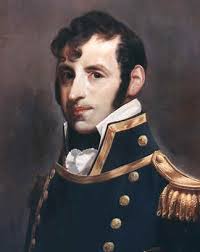
Commander Hunter DeRensis
The Barbary States had been totally conquered by the Americans, and DeRensis marched into Egypt in late September. Forcing the local Egyptian governments to accept American hegemony, the final nail in the coffin of the Turks' hopes for Mediterranean imperialism were squashed utterly in a humiliating fashion.
Wayne stressed that the corsairs not be allowed to further their murder and that an invasion should commence immediately. Hamilton, on the other hand, said that a naval blockade and small-scale bombardment, aiming only for structures and not people, would be the wiser move, and might possibly cause the Sultan to think twice about declaring an actual war. Needless to say, Jackson went with Wayne's roughnecked assault plan. Jackson and Wayne were two of a kind, and Hamilton sighed and tried to draft a new plan in early January.
Consulting with Russian and Austrian ambassadors, a plan for a three-pronged attack was planned against the Ottoman Empire. Field Marshal Mikhail Kutuzov was to take the Russian army and assault the Ottoman protectorate in the Crimea. The Austrian army, under Karl Philipp, Prince of Schwarzenburg, was to lead the Holy Roman Empire in a new crusade to demolish the Sultan's forces in the Balkans and lay siege to Constantinople, or, as the Mohammedans preferred, Istanbul. The American army and navy, meanwhile, was to utterly shellack all the corsairs and Imperial ships near Gibraltar and then sail on to Tripoli, where a large army of marines, under the young Commander Hunter DeRensis, was to storm the pasha's palace and take alive or dead the Berber leadership. Hopefully, the Turks would be confused and surrounded by its enemies and forced to accept a miserable peace. With Austrians and revolutionary Greeks and Bulgars assaulting Constantinople, the Sultan could not dispatch ships to aid the Berbers against the Americans if he had any common sense at all. With the Russians in control of the Crimea, the very real threat of invasion from the rear of Constantinople, over mainland Anatolia, was something that made every Turk tremble in his turban. With the Americans making mincemeat out of the Berbers, as they were expected to be able to do with a little help from the local Italian countries that had been taking Berber abuse for centuries, the Berbers would not only be prevented from sailing to relieve the defenders of Istanbul, but would be completely destroyed and their looting, raping, and killing halted for all time.
While this was hatched and begun to be put into motion, the citizens of Tripoli, not having a clue as to what was to befall them, began rioting at the American Embassy of Tripoli, where the garrison and ambassadors, under Major Gunther Miles, also had no knowledge of the coming invasion. Shortly after an assassin was killed during an attempt on Miles' life on April 22nd, shots were fired, and the garrison raked the angry crowds with musket fire. Trapped and surrounded by angry rioters, militias, pirates, and unsavory Turkish mercenaries, the Americans built the embassy into a fort, and assault after assault was beaten back. After two weeks of fighting, the invading marine force under Commander DeRensis stormed the shores of Tripoli, battering through poorly-trained and under-equipped Tripolitans and relieving the Defenders of the Embassy just in time. Within hours, the pasha was in custody and all of Tripoli was being brought quickly and decisively under American control.
Out at sea, the Genoese and Sardinian fleets had joined the American navy in a catastrophic hands-down massacre of the Barbary and Turkish fleet; thousands of Mohammedans were annihilated at the Battle of Tunis, where the Turkish and corsair ships had decided to make a stand following skirmishing with the American navy at Gibraltar. All remnants of the once-feared Imperial Navy fled like there was no tomorrow, docking in Cairo once news had hit of the waters around Istanbul being occupied by the Austrian Holy Roman fleet.
In the Balkans, the Greeks cheered and huzzahed as the Turkish army suffered heavy defeats at the hands of the Prince of Schwarzenburg. In late July, independence was proclaimed in Athens from the top of the Parthenon. Inspired, other Eastern European regions under the Sultan's fist rose up in a rage of nationalism and massacred their overlords.
Field Marshal Kutuzov had hijacked Crimea from the Empire in just over a month: May, 1799. The huge defeat meant loss of control of the Black Sea, and the Czar's men did indeed land in Anatolia and started a march to Istanbul.
In the Race for Istanbul, Austria and Russia tried to beat each other to the glory of accepting the Sultan's surrender. At last, in November, the Austrian officers entered under a flag of truce and made their way in a triumphal procession to Topkapi Palace, where the Holy Roman Empire gained the rights of half the city for fifty years and forced huge "reparations" down the Turks' throats, finally making the Muslims suffer the wrath of Constantine XI Palaiologos's successors. Constantino-Istanbul was born.
Commander Hunter DeRensis
The Barbary States had been totally conquered by the Americans, and DeRensis marched into Egypt in late September. Forcing the local Egyptian governments to accept American hegemony, the final nail in the coffin of the Turks' hopes for Mediterranean imperialism were squashed utterly in a humiliating fashion.
The U.S.-Chile War
"Huzzah for Chile Willy!"
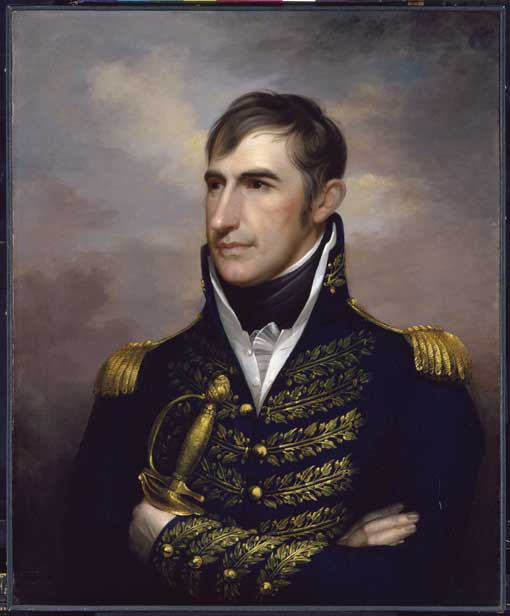
William Henry Harrison, Military Adviser to the USRP
"Huzzah for Chile Willy!"

William Henry Harrison, Military Adviser to the USRP
The history of mutual dislike between the countries of Chile and the United States of Rio del la Plata was as long as they had both existed: several years. In several years, however, they had certainly created enough hate for fifty. The main source of dispute was the Atacama Desert, an area so dry, it rained only four times every 100 years. However miserable, it was worth a fortune from all its copper and silver. Also, it would give the US good access to the Pacific and cut off Chile from Peru, a country growing more and more hostile to the US by the minute. And in the south, there had been unceasing quarrels over Cape Horn and Drake's Passage. Chile and Argentina wanted Cape Horn to control the South America-Antarctica Passage into the Pacific (Drake's Passage). America had long backed the like-minded USRP, while Georgia and the Southron Alliance had long backed Chile. All this meant war was practically inevitable.
In early 1801, President Hugo Jimenez of the US sent an ultimatum to Chile's consular government that all claims to Atacama must be dropped and that Cape Horn be gradually handed over to the US. When Chile refused, war was declared. In February, America sided with the US and declared war. Georgia knew it could not beat the Americans in its current state, so it did nothing but ship some supplies to Chile.
In Buenos Aires, the USRP capital, General William Henry Harrison had been stationed by Grand Marshall Anthony Wayne two years earlier, when Harrison's popularity was beginning to rival his own. For months, Harrison and his assistant, Colonel George Rogers Clark, had been rotting at desks. Finally, upon America's entrance into the war, they once again put on their combat uniforms and Harrison was appointed commander of all forces in South America. By early July, he had already lashed out, handily defeating the Chilean army under Bernardo Sanchez at Laguna Blanca, a horrid swamp. Thanks to new rub-on chemicals, some of Harrison's men were spared mosquito attacks, but the Chileans were not. Hundreds of Chileans came down with mosquito-related diseases, furthering the destruction of the army. Harrison then linked up with the USRP army in the south and marched upon Torres de Paine. At Torres, which was named after Thomas Paine, a bloody battle was fought during which Clark became a hero.
A week later, at Laguna San Rafael, yet another daring fight resulted in Clark finally earing the rank of brigadier general. General Clark was then dispatched north to Talca with a large USRP force. Drawing out some of the defenders from Concepion, Chile's capital, Clark created a gap for the armies of Maximilian Rodriguez, the United States' field marshal, and Harrison to expoloit. They marched quickly and stealthily along the coast to Valdivia and then, at breakneck speed, charged toward the Chilean capital. After a prolonged siege, the Chilean government, utterly crushed, surrendered. Over 20,000 Southron-made weapons were found in the surrendered stockpiles, and two Louisiana officers were arrested and then released for a large amount of cash.
Once again, America had come out victorious over its enemies. However, back in Britain, a document was about to be signed that would mark the beginning of the greatest war era in the last 100 years.
President Buonaparte
The Louisiana Election of 1802

The Louisiana Election of 1802

In the first two years of the 19th Century, Napoleone di Buonaparte achieved huge successes against Louisiana's enemies. In 1800, he successfully crushed the Quapaw Rebellion in Akansea. In that same year, he joined forces with Texan President Nicholas Young and helped crush Apache on their mutual border-frontier. Finally, in 1802, he announced his campaign for president. Wildly popular, he was expected to win in a landslide against Walter P. Phillips and Simon Leupold Alexander, two politicians with pro-Jacksonian thoughts, thought they would not admit it.
When the election rolled around, it was a massacre. Buonaparte won without even trying. Chancellor Jackson knew it was bad news for his plans of Manifest Destiny. With the pro-Georgian Buonaparte now elected, an alliance to destroy the American Republic seemed just over the horizon. What happened next was one of the worst errors in history: Anthony Wayne ordered his spy, Constance DuPont, lover of Napoleone's younger brother Jerome, to kill Napoleone at the inauguration in New Orleans City. Mingling with the friends and family members behind the new president on the inauguration balcony, she hardly attracted attention. Amid screams of horror, she drew a pistol and fire point-blank. Napoleone collapsed, apparently dead, to the floor, and guards immediately riddled Constance's body with musket balls.
President Buonaparte, however, was far from dead. The shot had hit him in the shoulder. It was promptly removed and he fully recovered. The failed assassination attempt was quickly blamed on America. When Jackson caught wind of the plot, he sacked Wayne and demoted him down to General, and installed Harrison in his place. An apology was not accepted by the Louisiana government, and behind closed doors, Britain's Arthur Wellesley signed an entente with Napoleon Bonaparte (the president had anglicized his name upon being elected). After a long meeting with all the Southron leaders, it was decided that an all-out coalition be declared in the winter of 1802 to destroy and break up the American Republic once and for all. Over 50,000 Redcoats were pushed up to the border, where a long series of trenches were built, fully-protected by artillery batteries. Panicking, General Wayne went off on his own again and encouraged revolt along the northern Atlantic border. Thus, the small but extremely important country of Madawaska was born out of bloodshed and violence.
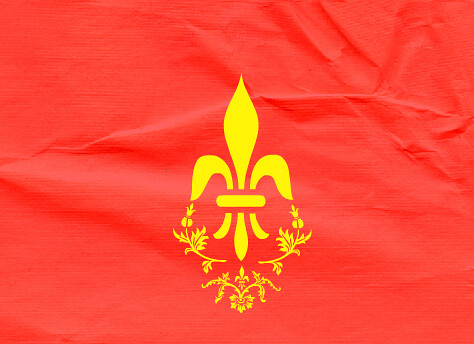
Flag of Madawaska
Britain's response was a declaration of war.
When the election rolled around, it was a massacre. Buonaparte won without even trying. Chancellor Jackson knew it was bad news for his plans of Manifest Destiny. With the pro-Georgian Buonaparte now elected, an alliance to destroy the American Republic seemed just over the horizon. What happened next was one of the worst errors in history: Anthony Wayne ordered his spy, Constance DuPont, lover of Napoleone's younger brother Jerome, to kill Napoleone at the inauguration in New Orleans City. Mingling with the friends and family members behind the new president on the inauguration balcony, she hardly attracted attention. Amid screams of horror, she drew a pistol and fire point-blank. Napoleone collapsed, apparently dead, to the floor, and guards immediately riddled Constance's body with musket balls.
President Buonaparte, however, was far from dead. The shot had hit him in the shoulder. It was promptly removed and he fully recovered. The failed assassination attempt was quickly blamed on America. When Jackson caught wind of the plot, he sacked Wayne and demoted him down to General, and installed Harrison in his place. An apology was not accepted by the Louisiana government, and behind closed doors, Britain's Arthur Wellesley signed an entente with Napoleon Bonaparte (the president had anglicized his name upon being elected). After a long meeting with all the Southron leaders, it was decided that an all-out coalition be declared in the winter of 1802 to destroy and break up the American Republic once and for all. Over 50,000 Redcoats were pushed up to the border, where a long series of trenches were built, fully-protected by artillery batteries. Panicking, General Wayne went off on his own again and encouraged revolt along the northern Atlantic border. Thus, the small but extremely important country of Madawaska was born out of bloodshed and violence.

Flag of Madawaska
Britain's response was a declaration of war.
The Fronts Take Shape
1803-04

By 1803, the continents of North America and South America had imploded into the most violent war ever seen. In the first week, tens of thousands perished, especially in South America, where the United States were just outright pummeling the remnants of Chile. Colombia used their rights to maneuver through Panama and smashed a British force gathering in Central America. A new Central States Republic was proclaimed under Colombian domination. British troops became bogged down in Belize, and unable to break out due to incursions by the Yucatan army and its Indian allies. Guatemala toppled its former government and allied itself with the British, however, helping immensely. Joseph Barton, supreme Dictador of the Confederate States of Mexico, lost no time in unleashing holy terror upon Yucatan, who he had been prepared tp invade for years. In the north, Tejas launched an invasion of Rio Grande, but had to go to war with the Glorious Republic of Chihuahua at the same time. In a thoroughly unsporting position, Tejas appealed to Bonaparte to send troops, but with massive battles erupting all along the Mississippi Front, only a token force of 1000 was sent. By mid-1803, Tejas was losing badly in its two-front struggle, and the total destruction of it navy by American Admiral Joseph Wilmington put a damper on all attempts to launch flank attacks into Rio Grande. 1803-04
If Louisiana thought it had it rough along the bloody, bloody Missi'ip Front, they had no idea what Georgia and South Carolina were going through. Andrew had a special kind of bone to pick with the bloated penal-colony-turned-empire and its eastern neighbor. As soon as the war had begun, the main force of the American army smashed through South Carolina's western edge and then into eastern Georgia, far behind Georgia's entrenchments and border fortifications. After a good frolic through several cities, the Americans were well-supplied and prepared to carry on a sustained effort behind enemy lines. The Georgian generals frantically moved most of their forces from their positions to counter the American flank-assault. The Americans simply retraced their steps back over the border into Carolina and then into America. Then, however, they suddenly rushed south and stormed Georgia's border defenses, taking them with minimal bloodshed. The Georgian army was now trapped directly on the border between America and Georgia, and now both countries entrenchments belonged to Jackson. In an utter annihilation, thousands of Georgians perished in the massacres until the South Carolinians came up to take up the vanguard position. The catastrophic defeat put a very nice dent in Georgia's war efforts, and until 1804, their main cause to keep fighting was to reclaim the huge amount of territory captured by Andrew. Grand Marshal Harrison held those positions until, as stated previously, 1804, when Georgian and British troops mounted a large assault and recaptured the forts, though half of them were destroyed. The Americans were still better off than before, as they had the opportunity to take the guns and cannons the Georgians had left behind. As soon as the forts were retaken, Georgian militias brought up thousands of negro slave laborers to rebuild the forts. America, the enlightened North, used it as propaganda; though slavery was still legal in the Republic, it was far from common, and there were few uses for slaves to begin with in the industrialized country. Many slaves attempted to escape North, but Georgian cavalry patrols, who bore the brunt of the fighting and skirmishing along the border, usually rounded them up and put them back to work.
Along the Missi'ip Front, Bonaparte was launching raids in the north to tenderize it for invasion. He would have done it sooner had Britain come through with its promises of sallying forth from the north to assist. Instead, Wellington was launching assaults into Maine and the Green Mountain Republic, and Bonaparte was left with an awkward, bloody front, with Tenasee pretending to fight, Watauga trying to fight, and morally-wavering Kaintuck refusing to fight. Louisiana may have extended for hundreds of miles west, but at this point, all that mattered was that narrow strip of land along the river. America wasn't facing the raids lying down either; several cross-river landings by the Republican Marines, the infamous Greencoats, had put lead bars in the cogs of Louisiana's military machine, resulting of course, in an ugly screeching noise. As time dragged on and no advances were actually gained by either side, Bonaparte began considering new ideas.
As 1804 arrived and the shock of the surprise late-1803 entry of France into the war on behalf of Jackson wore off, the conflict once again stagnated into brutal raids and counter-raids. Cavalry's mobility actually was the main reason for the stagnation, ironically. Cavalry had seen a rebirth in the prior American conflicts, but was now leading to any advances made being untenable to hold. The supplies for the horses, after such a long period of destruction along the frontlines, could no longer be scavenged from farms, as those farms no longer existed, never mind towns. When infantry were brought in to reenforce the cavalry, things usually went well. When they were not, the other side's cavalry came in and pressed them out after letting them starve. Prisoner exchanges became so numerous that the military paperwork from those countries of that time is so completely disoriented and fuddled that not even trained scholars can follow it very well.
As weak British forces in Canada found themselves being overwhelmed by "Mad" Anthony Wayne and its own growing Quebec independence movement, the focus shifted to defense of its current borders. Also, French blockades in Europe were crippling the shipment of new troops and supplies, especially to Belize, which was overrun by Yucatan and Colombian forces in January. Guatemala was about to topple alongside it when Barton rushed his army in and took control.
Tejas was losing in a very sharp fashion. Chihuahua was running out of men, but so was Tejas. And thanks to Tejas' war with Rio Grande, it was running out faster.
In America, with things going so well, Andrew's popularity reached new heights. An unstoppable political force, portraits of him hung everywhere, armbands with his monogram were all the rage, and many women kept a picture of him in lockets around their necks. Hamilton noticed the popularity without difficulty, and, in a letter to Grand Marshal Harrison dated September 11th, 1804, claimed he had "a most wonderful vision of America's future" in the planning stage, and that he would pitch the idea to Jackson "very soon." What that suggestion was was about to completely reheat the war and send the other countries the message that they were playing on a bigger, tougher, more... regal, playground.
Old Hickory Becomes King
Jackson had been somewhat skeptical about Hamilton's plan for a monarchy. His huge popularity made him untouchable, claimed Hamilton, and the people would welcome it just as they had welcomed the 4th of November Coup d'etat. Upon consulting with high-ranking officers and government officials, Jackson realized that even if some of the citizens did turn violent over a monarchy, the majority would instantly brand them traitors and report them. On January 1st, 1805, the Coronation of His Majesty King Andrew I, of the House of Jackson, the First King of America was to take place.
* * * * * *
Location: Independence Hall, now Coronation Hall, Philadelphia
"Make way! Make way!" shrieked a cavalry officer as he tried to clear the newly named "Jackson Avenue." His loud voice could be heard through the scarf that covered his neck and face up to his nose. It was 30 degrees outside that fateful morning, but that did not stop what seemed like half the country from showing up to watch the crowning of their first king. Trumpets blared, bands played a new Jacksonian march that had become popular, and thousands of civilians talked loudly in anticipation. The officer's men came up behind him, using riding crops to wave at the citizens to get them to get off the cobblestone street. They wore blue uniforms with red trim, white shirts and pants, bicorns, and rapiers. Many were also bedecked in their medals from the French and Indian War, Great Revolution, and the ensuing conflicts. There were barely any French and Indian War veterans still in service, but some had donned uniforms once more for the coronation. Coming up Jackson Avenue came the "security guards" for the event; The Royal Legion.
The Royal Legion was Jackson's first act as a leader. Only the most loyal and experienced veterans of the War for Independence were allowed in. During the 4th of November Coup, they had always been at his side. Now, they would see their general become king. They wore shakos with large red, white, and blue plumes in the front, blue coats with yellow trim, jackboots, and crimson shirts and pants. They marched, drums beating and banners waving, in front of Coronation Hall. Once they arrived, the crowd immediately stepped to the side.
Then came the coaches with newly appointed nobles and government officials. First was General Wayne, Duke of Easttown, and his wife Sarah. Then William Henry Harrison, Grand Marshal of the Army. Then came the soon-to-die Daniel Carrol, Duke of Prince George's County, Maryland and soon-to-be Viceroy Henry Dearborn. Notables from other other countries were also present, such as Rodrique y Marina from Spain and Lafayette from France.
Finally, Dolley Jackson arrived in royal splendor. Bedecked in elaborate clothing and surrounded by armed guards, she walked up the steps and into the magnificent Hall.
And last came Jackson, riding in a blue coach encompassed on all sides by cavalry. The crowd went wild as they watched their hero step out and wave his bicorne. He was immediately escorted inside, where he walked down the carpet and up to the coronation area. There, lying on a velvet cushion on a mahogany table, was his crown. Next to it, on another cushion, was Dolley's. At first, it looked as if Grand Marshall William Harrison would crown him, but then Jackson picked it up and put it on his own head.
Immediately, a dragoon holding the new red-white-and-blue flag blew his trumpet.
"All Hail King Andrew I! Long live!" boomed another soldier.
"Long live King Andrew! Long may he reign!" recited the crowd whole-heartedly.
Jackson then picked up the smaller crown and put it on his wife.
Another trumpet followed, and another "long live" after that.
After Jackson and his wife sat down on two fairly humble-looking thrones, the newly-established Royal Musicians, from stands set up behind the coronation platform, boomed out the new anthem.
And from [FONT=Arial, Helvetica, sans-serif]where is[/FONT]
[FONT=Arial, Helvetica, sans-serif] that band who swore,[/FONT]
[FONT=Arial, Helvetica, sans-serif] That battle's desolation[/FONT]
[FONT=Arial, Helvetica, sans-serif] and the havoc of war,[/FONT]
[FONT=Arial, Helvetica, sans-serif] A home and a country[/FONT]
[FONT=Arial, Helvetica, sans-serif] should leave us no more![/FONT]
[FONT=Arial, Helvetica, sans-serif] Their blood has washed out their foul pollution.[/FONT]
[FONT=Arial, Helvetica, sans-serif] No refuge could[/FONT]
[FONT=Arial, Helvetica, sans-serif] save the hireling and slave,[/FONT]
[FONT=Arial, Helvetica, sans-serif] From the terror of flight, [/FONT]
[FONT=Arial, Helvetica, sans-serif] or the gloom of the grave,[/FONT]
[FONT=Arial, Helvetica, sans-serif] No safety could be found [/FONT]
[FONT=Arial, Helvetica, sans-serif] by the knave,[/FONT]
[FONT=Arial, Helvetica, sans-serif] And the star-spangled banner in triumph doth wave![/FONT]
[FONT=Arial, Helvetica, sans-serif] [FONT=Arial, Helvetica, sans-serif] that band who swore,[/FONT]
[FONT=Arial, Helvetica, sans-serif] That battle's desolation[/FONT]
[FONT=Arial, Helvetica, sans-serif] and the havoc of war,[/FONT]
[FONT=Arial, Helvetica, sans-serif] A home and a country[/FONT]
[FONT=Arial, Helvetica, sans-serif] should leave us no more![/FONT]
[FONT=Arial, Helvetica, sans-serif] Their blood has washed out their foul pollution.[/FONT]
[FONT=Arial, Helvetica, sans-serif] No refuge could[/FONT]
[FONT=Arial, Helvetica, sans-serif] save the hireling and slave,[/FONT]
[FONT=Arial, Helvetica, sans-serif] From the terror of flight, [/FONT]
[FONT=Arial, Helvetica, sans-serif] or the gloom of the grave,[/FONT]
[FONT=Arial, Helvetica, sans-serif] No safety could be found [/FONT]
[FONT=Arial, Helvetica, sans-serif] by the knave,[/FONT]
[FONT=Arial, Helvetica, sans-serif] And the star-spangled banner in triumph doth wave![/FONT]
[/FONT]
[FONT=Arial, Helvetica, sans-serif] O'er the House of the King, and the House of the Queen, and the Land of the Free, and the Home of the Brave![/FONT]
[FONT=Arial, Helvetica, sans-serif] O'er the House of the King, and the House of the Queen, and the Land of the Free, and the Home of the Brave![/FONT]
[FONT=Arial, Helvetica, sans-serif] O'er the House of the King, and the House of the Queen, and the Land of the Free, and the Home of the Brave![/FONT]
[FONT=Arial, Helvetica, sans-serif] God Bless the King, God Bless the Queen, God Bless the Free, and God Bless the Brave![/FONT]
[FONT=Arial, Helvetica, sans-serif] (tune is this song: [/FONT]http://www.youtube.com/watch?v=lGlxT...eature=related )
[FONT=Arial, Helvetica, sans-serif] O'er the House of the King, and the House of the Queen, and the Land of the Free, and the Home of the Brave![/FONT]
[FONT=Arial, Helvetica, sans-serif] O'er the House of the King, and the House of the Queen, and the Land of the Free, and the Home of the Brave![/FONT]
[FONT=Arial, Helvetica, sans-serif] God Bless the King, God Bless the Queen, God Bless the Free, and God Bless the Brave![/FONT]
[FONT=Arial, Helvetica, sans-serif] (tune is this song: [/FONT]http://www.youtube.com/watch?v=lGlxT...eature=related )
[FONT=Arial, Helvetica, sans-serif]One of the most important announcements King Andrew made after the coronation was that Muskogee had agreed to join the Union... of Royal American States, if the war should be won. There was another huge announcement: a new constitution was being drafted and the American Republic had been renamed the URAS; the Union of Royal American States. The Republic was now officially a footnote in history.
And so, on January 1st, 1805, Andrew Jackson crowned himself king, and the Jacksonian Wars truly began.[/FONT]
The Government of the URAS
"I Pledge Allegiance to the Crown of the United Royal States of America, and to our United Kingdom, for Which it Stands, Under God and the Rule of Law, with Liberty and Justice for All Free Men. God Save the King."
-Pledge of Allegiance to the Crown, written by Duke Francis Key, Poet Laureate (1805)
-Pledge of Allegiance to the Crown, written by Duke Francis Key, Poet Laureate (1805)

The government of the URAS was similar to Britain. It was an hereditary constitutional monarchy with a prime minister and a parliamentary congress. However, there were several key differences. Here is a basic summary of the Royal American government:
Government Levels:
King/Queen
Prime Minister
Viceroy
Grand Duke/Grand Duchess (The Heir Apparent)
Viscount/Viscountess (The Other Royal Children)
Governor
Duke/Duchess
Lord Secretary of the Treasury
Lord Secretary of the Army
Lord Secretary of the Navy
Lord Secretary of Education
Minister of the House of Congress
Member of the House of Congress
Military Ranks:
Grand Marshal
General
Lieutenant General
Brigadier Colonel
Lieutenant Colonel
Major Captain
Lieutenant
Second Lieutenant
Officer Cadet
Grand Sergeant
Sergeant
Corporal
Private
Other:
Slave
The King:
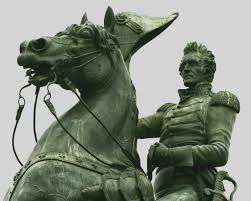
King/Queen
Prime Minister
Viceroy
Grand Duke/Grand Duchess (The Heir Apparent)
Viscount/Viscountess (The Other Royal Children)
Governor
Duke/Duchess
Lord Secretary of the Treasury
Lord Secretary of the Army
Lord Secretary of the Navy
Lord Secretary of Education
Minister of the House of Congress
Member of the House of Congress
Military Ranks:
Grand Marshal
General
Lieutenant General
Brigadier Colonel
Lieutenant Colonel
Major Captain
Lieutenant
Second Lieutenant
Officer Cadet
Grand Sergeant
Sergeant
Corporal
Private
Other:
Slave
The King:
At any moment, the King could depose the Prime Minister and/or Viceroy. They served, after all, at the pleasure of the King, who was, at least with Jackson, the Founding Father. His wisdom was not to be questioned. As time went on, however, this "Divine Right of Jackson" grew unpopular, and he decided to try to keep his hands off for the duration of their terms.
New States that entered the Union had to be approved and named by the King. However, the King could not start the process of statehood. The Territorial Governor wishing for statehood and the Prime Minister of the country had to publicly and formally come before the King, bow, and read the Request for Statehood. With Scepter and Orb in his hands, he would say yes or no. If it was no, it was a huge letdown, and no ceremonies of this type ever ended in this manner. Upon a yes, the Viceroy, who was standing beside the King's throne, would take the written request and put the King's wax seal on it. The Territorial Governor and Prime Minister would then bow, thank the King, and then leave. The flag of the new state was then designed according to the style and traditions of the new state by the Royal Colour Guard, an elite group of officers in charge of all flags in the Kingdom. Safe to say, the King and the new State Governor had their fair share of input on its design. If the Prime Minister or Governor disliked the new flag, they could ask the King to have it struck from the records and have a new one designed. If the King did not like the new flag, he could simply say no and the flag would be redesigned.
The King did not have the power, per se, to declare war on his own authority, but needed the endorsement of the Prime Minister and House of Congress. That being said, the Prime Minister could be toppled on a whim by the King, and the Congress was extremely loyal to the King, especially under Jackson.
No justification was needed for a war. The only thing that mattered was that three branches of government agreed with each other.
The King had absolute power over military fashion and could promote any officer he wanted and sack any officer he wanted. All uniforms were designed according to the King's desires, but Jackson's designs and color codes were by far the most popular. The King could create as many regiments as he pleased. Many other government figures could do the same, but they had to pay, clothe, supply, and equip their soldiers out of their own coffers. There was a limit to their control, though, and the soldiers obeyed the King and the Marshals and Generals foremost. The most common privately-owned regiments belonged to Governors, Members of the House of Congress, Mayors, the King's relatives, and upper nobility.
The Prime Minister and Viceroy:
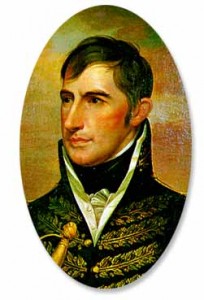
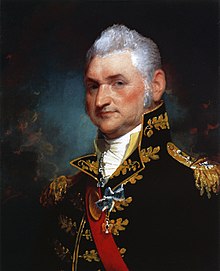
PM William Henry Harrison and VR Henry Dearborn


PM William Henry Harrison and VR Henry Dearborn
The Prime Minister had a Viceroy. Like many words and occupations in America, it did not mean the same thing as in Europe. The Viceroy worked directly under the Prime Minister and was next in line to the office. If something happened to the Prime Minister, the Viceroy took over. The Viceroy also served as the honorary Deputy of the House of Congress.
The Prime Minister was not elected. The King had the duty of selecting whomever he saw fit. However, he listened to Popular Opinion to prevent unrest, and thus the candidates had cross-country campaigns to win over the public. Prime Ministers could serve only two terms of four years each, but they could run again after the next election. Over the years, many campaigns were corrupt and blackmailed or bribed the populace into holding parades and rallies to make the president choose their candidate.
There were various parties in the URAS for the government officials to choose from, like the Sons of Liberty Party, Fraternity of Freedom, America Party, Whig Party, etc. The Sons of Liberty Party and its successor organizations, however, were shut down in 1806 as an enemy of the state.
Grand Duke/Grand Duchess(Heir Apparent):
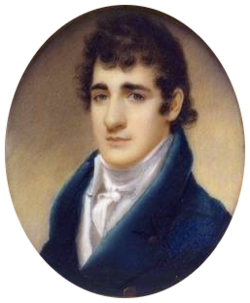

The first Heir Apparent of the URAS-Andrew did not have a biological male child (males were supposed to inherit the throne over females no matter the age of the female sibling)-was his thirteen year-old step-son, John Payne Jackson, titled John, Grand Duke of New York. When he came of age, he was to be the only man besides the King and Prime Minister who could give orders to the Grand Marshals. The Grand Duke had his own private regiments, and they formed the Grand Duke's Own elite fighting force. Over the years, the Grand Duke's Own developed a reputation as the best Indian-fighters on the continent, rivaled only by Louisiana's Corsican Volunteers.
Viscount/Viscountess:
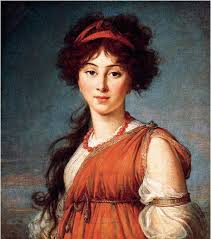
Viscount/Viscountess:
The other children in the royal household were all Viscounts and Viscountesses. Andrew had a stepson (Dolley's son the Grand Duke John) and his own daughter by Dolley, Gwendolyn Jackson, who was titled Viscountess Gwendolyn I. The daughter's name led to some controversy about the King's relationship to one of his earliest supporters, Gwendolyn Jones, the famous "Liberty Lady" of the Battle of Sparta.
The Viscounts were to be either soldiers or diplomats. Viscountesses were to be aides to the Queen or diplomats.
Governor:
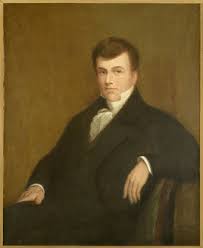
The Governor's of states and territories had very few powers. Largely, they simply collected taxes, repaired roads, payed their officials, protected their borders, and served King and Congress.
Duke/Duchess:
An honorary title, Dukes and Duchesses usually were people who had done outstanding service for the country. The very first Duke was Anthony Wayne, hero of the War for Independence and the following conflicts, despite his sometimes huge errors. He, at official occasions, was addressed as "His Excellency, the Duke of Easttown, General Anthony Wayne."
Lord Secretary of the Treasury:
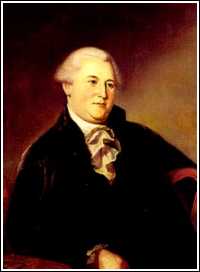

The Lord Secretary of the Treasury managed most of the finances of the Kingdom, and kept his thumb over the Governors' purses. He was in charge of punishing embezzlers. The first man to hold this rank was Lord Bedford, Revolutionary figure Gunning Bedford, Jr. Appointed by the King, as all Secretaries were, in 1806, he hanged over two hundred embezzlers, ranging from petty officials, to the Governor of Metropotamia, Henry Smith.
Lord Secretary of the Army:
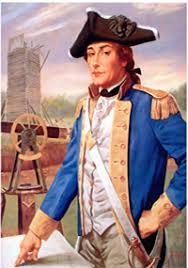
The Lord Secretary of the Army helped the King and his officers organize finances for the army, from supplies to weapons to pay. He was largely only active during wartime when the army was on campaign, as most regiments were typically stationed in their native states, where the governor used state taxes to pay and feed them. The first Lord Secretary of the Army was Tadeusz Kośiuszko, shown above.
Lord Secretary of the Navy:
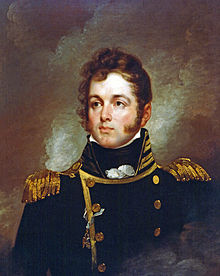

The Lord Secretary of the Navy as an office did not exist until 1807, when Lord Oliver Perry, 1st Duke of South Kingstown, was put in charge of the growing fleet when it grew too large for the Army Secretary to keep up with. He did the same things as the Army Secretary, only he did it during war and peace, as the ships had to constantly be maintained and repaired.
Lord Secretary of Education

The Lord Secretary of Education had the duty of running America's schools and colleges, especially in the realm of censorship. Thanks to the first man to have this job, Noah Webster, the author of the famous Lord Webster Readers, the next generation of Americans were card-carrying monarchists to the hilt.
Minister of the House of Congress:
A Minister, such as Henry Clay, pictured above, was a person who helped keep the Congress orderly. At all times, they were in a group of 6, in hopes that two would always be present. Sometimes, during emergencies the other Ministers could not travel fast enough to deal with the problems. One Minister would hold the gavel, and the other would deliver the King's Daily Address, a ghost-written document revealing what what the King wanted accomplished that day. Often, the Congress would erupt into vicious arguments, which the fatherly ministers had to put down.
Member of the House of Congress:
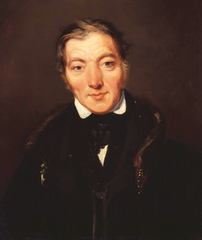

The Members of the House of Congress, such as Welshman Robert Owen (above) of Polypotamia and one of the earliest proponents of socialism, were ten men from each state, elected by the people every six years. This was the only important office for which elections were held. The Members tried to accomplish what their constituents wanted in a way that would be agreeable to the king. Once a majority of the Members agreed that the law or regulation was good (and the majority was just that, sometimes only by one vote!) they would have the Viceroy, the Deputy of the House, who was rarely present, present it before the King for approval. If the King approved, it was called a Royal Decree, and was read aloud in every state capital and in many towns and cities. Many of these Members also funded, but rarely led, their own private regiments, which led to a huge and ersatz variety in uniforms and standards. The Members largely had regiments as status symbols and little else, and appointed sons, nephews, and grandsons to leadership in these "private armies."
The World Reacts

Monarchists revolt in Louisville, Kaintuck

Violence in New Orleans City

Blue-coated American troops are attacked at night by Wellington and his Indian allies near Detroit, Chersonesus
As soon as the coronation occurred, riots broke out all over the continent. America had turned her back on the ideology and tactics of the Revolution once and for all. Impaling was outlawed, new branches of the ever-expanding government were established (largely under the pretense of winning the current war), and the Sons of Liberty and its shadow organizations were shut down once and for all.
In Madawaska, where Revolutionary fervor had been extremely high and a deciding factor in its decision to break away from Canada, some of the people rose up, but were fairly quickly put down by Anthony Wayne.
In New Brunswick and Nova Scotia, pro-American riots broke out against the British government, under the reason that those two areas had more in common with an American monarchy than a British one. Both were successful, with the help of Anthony Wayne, in declaring independence. Nova Scotia and New Brunswick did not become states, at least, not immediately, but were satellites of Jackson's URAS. The complicated and very mixed feelings on the part of the Canadians about fighting fellow Canadians led to the British army having to ship thousands of more troops from Europe just to fight in the two new countries. Soon, Jackson pulled strings and united Madawaska and New Brunswick into one country, the Principality of New Brunswick, which gave them a growing sense of nationalism and the will to fight on.
In Kaintuck, a monarchist movement inspired and led by the twenty year-old David Crockett overthrew the already pro-Jackson government and took a vote for king. Crockett won with eighty percent of the vote and became King David I, and received a big fat stamp of approval by Jackson in the form of money and weapons. Louisiana reeled from the new attacks.
King David I
1805 Monarchical Standard of Kaintuck, featuring the Crockett coat-of-arms
In Tenasee, not quite a micronation but close enough, the government put its troops in the towns and on the border (especially its tiny border with Virginia), and refused to let radicals topple the Revolutionary government. It declared an end to any and all hostilities with its neighbors and tried to focus on stabilizing itself.
Watauga was on the verge of total collapse already by the time of Jackson's coronation. The bloody infighting that had been going on for decades combined with the horrendous military defeats its troops had suffered were bringing it down. By late 1805, Watauga's government had been overthrown by pro-Kaintuck monarchists. Georgia immediately moved in and occupied the country in an indefinite state of martial law.
In Gran Colombia, the once strongly Republican government was so impacted by American influence that it kept right on treating Jackson as its most trusted ally. In the rest of South America, huge pro-monarchy revolts broke out, especially in Brazil, where the banning of impaling only slowed the rise of a new imperial monarchy.
In Tejas, Chihuahua, Yucatan, and Rio Grande, the violence and anarchy of the ongoing war kept everyone's minds off politics and onto survival. The borders of Tejas were so battle-torn and bombed-out that it was said that there were literally entire herds of deer and other desert animals that had been accidentally killed just lying, rotting in the sun. Many of the native tribes were being pushed to extinction and tribal "civil wars" had been becoming increasingly common, with Comanches killing Comanches over disputed resources.
In America, the public rallied and a new wave of volunteers hit the recruiting stations. Tales of knights and other examples of royal splendor became all the rage, leading to an outbreak of propaganda novels such as Alexander Mansum's The Count of Christ Mountain, about a Great Revolution veteran abandoned to the British army during the Battle of Gunpowder Hill (1781) escaping a dank prison in the Falklands, earning an appointment in Jackson's new government, and returning to Christ Mountain, in North Carolina, to get his revenge on his former regiment members. It became an instant classic, and even became popular in Europe. Further promoting a "grand monarchy" spirit, Jackson's architects unveiled blueprints for a massive palace in Philadelphia, at the center of which was a huge fountain. Hence the building was to be named Blue Fountain and was scheduled for completion by 1818. It was hugely delayed by war, however.

Original 1806 Blueprints of Blue Fountain Palace (from left to right: National Church, House of Congress, Coronation Hall, Royal Museum; the rest of the mammoth structure was to be divided up between living quarters, barracks, and government offices)
In America's African colonies, the new government proved much more popular with many of the Muslims and Berbers, as they were used to and respected monarchies, such as the Ottoman Empire.
In the rest of Europe, there were mixed feelings about the upstart Andrew. Prussia still felt strongly tied to Britain, and in Britain, parents told their children that if they did not behave or obey, "Old Hickory will come in the bloody window an' haul your bloody rear all the way t' Philadelphia." But Louis the Sixteenth's France became much more positive in its involvement in the war, and Russia announced a new plan to land on the west coast of America and march to Chihuahua and assist in defeating Tejas and Mexico.

"We are in a position to lose all our holdings in the Western Hemisphere!"
-Arthur Wellesley, Duke of Wellington, in an 1806 letter to British Prime Minister Sydney Smythe (Elected in 1804 from the Cheshire Constituency)
"As I look about our government, I see that there are certain men of certain leanings in the House of Congress that are utterly steadfast in doing what is right. And then there are those who do not follow His Majesty's advice."
- Lord Secretary of Education Noah Webster, 1806
"The Kingdom of the States was made not merely for the generation that now exists, but for posterity- unlimited, undefined, endless, perpetual posterity."
- Minister of the House of Congress Henry Clay, 1805
The start of 1805 had brought a new government into existence, and a new monarch needing to prove just how he deserved the position. To kick off his new reign, Andrew and his generals, and with the help of the Lord Secretary of the Army, Tadeusz Kośiuszko, arranged a plan for the total annihilation of America's enemies. There was one other person involved in the plan, a very unexpected ally: President Bonaparte.
Louisiana had been complaining about getting the short end of the stick for most of the war. Wellington had promised to send troops south for what seemed like a century. Instead, the British army was concentrated on breaking through to New England and Pennsylvania. Thousands of Louisiana's men had died in its attacks in and out of Polypotamia and Illinoisa, on America's side of the Mississippi, and, more recently, in Louisiana itself, where American forces had been breaking through and holding ground. Tejas had requested help from Louisiana, too, which, of, course, Louisiana could not possibly do. To top things off, Joseph Barton, Mexico's dictator, had publicly called Bonaparte a coward. Enough was enough.

American Bluecoats (44th Pennsylvania Jäger Regiment) overwhelm the white-gray uniformed Louisiana 32nd Chasseurs à Cheval during the bloody American victory at Wabash, Polypotamia
President Bonaparte (dark green uniform, standing on raft, center) greets King Andrew I (dark blue uniform, gray-brown hair, left) and URAS Marine commander and North Africa veteran Hunter DeRensis, Duke of Winterfell, Pennsylvania (removing hat, center); to the far right is David I of Kaintuck (sky blue uniform)
In late 1805, just after a sudden and mysterious troop withdrawal from central and northern Louisiana to the southeast, Bonaparte, Andrew, and David I personally met in the center of the Mississippi River on a raft, near the small Louisianan town of Tylzasippi, and there, they changed the world. After discussing matters for an hour so, the three leaders realized they had much in common, and not just ego size. The trio believed that the Great Revolution might have been unavoidable, but it was too extreme. Moderation was now needed of the hot-headed radicals now in control of the other parts of North and South America. Only Colombia and Britain had any evidence of being moderate, and Britain was allied to the radicals for nothing but revenge and rage. This new era of moderation needed to be brought about by defeating Britain and its allies decisively and quickly. Jackson alone, as great a commander as he was, could not likely do it decisively, and certainly not quickly, with Britain so hellbent on wiping out a nascent new rebel kingdom. Bonaparte became convinced that he would be doing the world, and his country, a favor by switching sides. A deal was struck, and Bonaparte said of Jackson after the meeting that, "Were His Majesty King Andrew a woman, I would marry her. Clearly, I must ask my father when I meet him in Heaven, or Hell, if he had another son named Andre. His Majesty David struck me as... masculine, I suppose. Nothing nearly as brilliant Andrew, who is old enough to be his father." This new friendship brought out that both Bonaparte and Andrew shared a love for Voltaire and a hatred of traditional music. At a meeting a week later in Tylzasippi itself, an American military band went up against a Louisianan one. Both leaders left impressed. David held the opinion that "fiddlin' is fer effeminate dandies. Gimme a rafle and some woods and that's music to my ears," which reportedly received a snicker from Andrew.
A day after, they came to an accord on international affairs, and recognized the new Kingdom of Kaintuck, the Duchy of Wataga (rebel government-in-exile of Georgia-occupied Watauga and led by Napoleon's youngest brother Jerome), and the Free City of Saint Louis (which was to be governed by Napoleon's older brother, Mississippi River trade tycoon Joseph). Saint Louis was one matter of tension between the new-found best friends and King David, but the decision that it would be a free city was granted reluctant approval by the King of the Wild Frontier. Joseph would be Généralissime de Saint-Louis, formally. The bloated ego of Napoleon's oldest brother liked this very much. Jerome was to be General-Duke of Wataga, which was not nearly as wonderful as it sounded, and it was more "General" than "Duke." At this point, Wataga/Watauga was a hellhole and the most unstable place on the continent. Jerome, if his new homeland gained full independence, was to be in command of a militarized buffer state created to solely to further break up areas along the Georgia border. Tenasee was left alone, and America and Georgia started to use the moderated country's Swiss-style banks.
Andrew remarked a year or so later, while looking at a globe in his office, that America was starting to look like a reversed/flipped map of Europe; Britain on both continents' coasts, cold areas to the north, Francophones to the south, Spanish-speakers to the deep south, colonialized savages on the continents below, fractured puppet satellites along the Rhine/Mississippi, and a giant, largely unexplored country, Louisiana, at the end, comparable with underpopulated Russia in Europe. He thought it rather amusing how it had worked out that way, almost as if by design or deliberate analogue.
When the world at large learned of the turncoating, it was shocked. In February of 1806, Louisianan troops swarmed into Watauga/Wataga in full-force under the control of General Harold Bentworth. British-born Georgian General Alexander Richards rode out with a massive cavalry force to attack Bentworth's flank, but actually deliberately led his men into a large trap. The entire cavalry force surrendered without firing a shot, and Richards, a moderate Republican, raised his sword to the Louisiana Eagle Flag and took backwoods militia, riding on the horses the Georgians rode to the surrender, and pummeled a huge gap into the Georgian line. Half of Wataga, and its capital of Nashburg, fell to Louisianan hands.
Andrew used the advance as a distraction to keep his moves secret, and then, like a chess master, launched mad Anthony Wayne into Quebec, thrusting through several Wellington-led counter-attacks, and battling it out near Saint Simon. The disasters unfolding were compounded when French forces land in Newfoundland. Wellington blamed London for his misfortunes, and pleaded for new troops and for the British Navy, under Horatio Nelson, to come and destroy the French fleet at Newfoundland. The French army in Newfoundland was finding itself anything but unwelcome, and the Francophone population was thrilled by the very nonviolent invasion and occupation. Wellington claimed that at this point the French commander, the "accursed" Marquis de Lafayette, could join Wayne in a march on Quebec. Quebec's loyalty was anything but deep, and many hated Wellington for his open hatred of anyone who spoke French. If Quebec fell, so did British America. Wellington said in a letter to his friend and British Prime Minister, the radically revenge-driven Great Revolution veteran Sydney Smythe, that "If Quebec falls, we are in a position to lose all our holdings in the Western Hemisphere!" Smythe, whose two brothers had been impaled at Ticonderoga with Burgoyne, was boiling over with rage, and had to write back the truth: In early June of 1806, the French and American Royal Navies sank the British fleet at Trafalgar in a bloody, climactic, Nelson-killing rout. Nelson had been trying to come through the Pillars of Hercules to attack American North Africa and French Corsica. Admiral Michel Ney had learned of the impending attack and had been more than ready for the battle. Admiral Ney had actually joined the final boarding party and personally shot Nelson in the chest. King George's navy and its leader had been annihilated. Reinforcements would not be coming.

Horatio Nelson dies of wounds surrounded by sympathetic American officers in the hold of the HRMS Benjamin Franklin

The HMS Victory destroys the HRMS Lucky Lucy shortly before French commander Michel Ney fires the battle-ending gunshot
Last edited:
